Duke Nukem’s Big Shot Pinball: (Pinball M Table Review)

Duke Nukem’s Big Shot Pinball
Platform: Pinball M
Set: Death Save Bundle ($19.99)
Individual Price: $5.49
Designed by Grego “Rockger” Ezsias
Originally Released November 30, 2023
❄️🔥POLARIZING TABLE🔥❄️
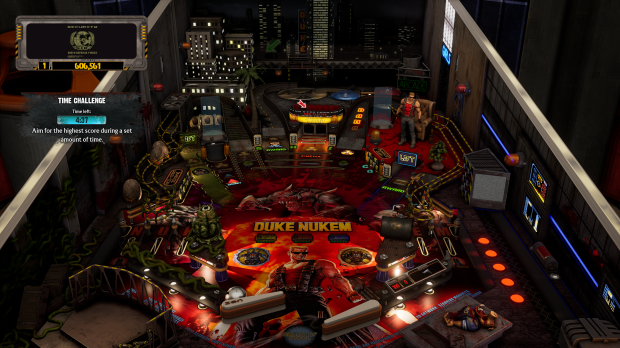
Insert any Duke Nukem quip HERE. I’ll do it: “I’m an equal opportunity ass kicker.” Now just repeat that every time the ball touches something.
Right off the bat, I need to inform you, my beloved reader, that none of the Vice Family are Duke Nukem fans. That doesn’t mean we’re against the franchise. It just doesn’t interest us. Taking it further, Oscar and Angela have no experience at all with the games (Dad might have played 3D at some point but only briefly). Having been squirted into the world in 1989, I was born at the wrong time to really care about the IP. So, we all deferred to Dash, our resident Duke Nukem fanboy. He both enjoyed the pinball layout Grego Ezsias and the team at Zen Studios created AND he also believes that Duke Nukem’s Big Shot Pinball canonically fits alongside the rest of the franchise. In other words, he could believe that this was an official release by Duke’s creators. Jordi, also familiar with Duke Nukem, agreed. From the theme integration to the call outs to the modes: this could be a legitimate stand-alone Duke Nukem release and it’s unlikely any fan of the series wouldn’t believe it. It’s a fitting tribute to Duke Nukem 3D and if you’re a big fan, what’s here should be authentic enough that you’ll feel at home. So, I’m just going to focus on the pinball stuff.
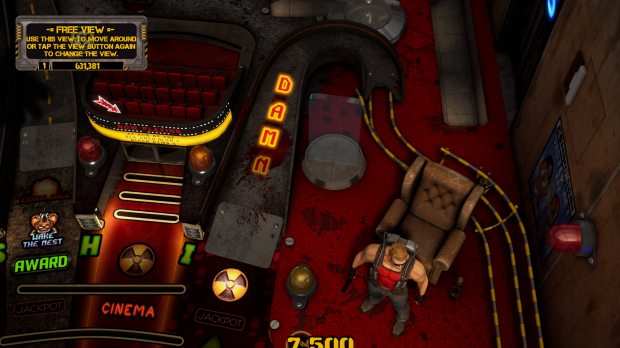
Unique among Zen’s pins is that Duke Nukem has no traditional driver. The Cinema shot is low-yielding as its own thing and has a mini-mode attached, but we were mostly using it as a dumper to safely gain control of wild balls. Lighting the D-A-M-N letters off the right ramp and shooting the toilet scoop starts modes, but you’re given so much freedom to explore the layout that it never really feels as if you’re being queued into the modes. Odd.
With the exception of Dash, the main issue we all took with Duke was the ball return. Whenever the ball transfers from the bumpers to the main playfield, it goes through a hidden habitrail before exiting out underneath the DAMN ramp. And it returns at an angle where the ball sort of lobbed carelessly. It’s so off-putting. It’s treating a pinball return the same way a slob wads up trash like hamburger wrappers and casually throws them in the general vicinity of a garbage can, unbothered by whether or not they actually go in the can. It never comes out at the same speed or trajectory, and since the ball inevitably hits the slingshot, the probability that any returned ball could become unplayable is higher than any made shot should be. The fact that the design specifically drops the ball into the highly lethal left slingshot is incredibly frustrating. There was no rational or logical benefit from any design perspective for having it do this besides punishing players for wanting to play the table in the first place. Hey, if Zen wants pins to be less fun than they can be, I suppose that’s their god given right, even if I don’t get it.
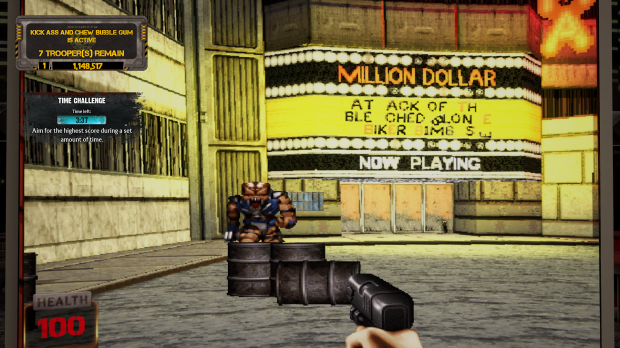
One of the three main modes (Kick Ass and Chew Bubble Gum) is a glorified video mode that pays homage to the Duke Nukem franchise. Aliens will pop-up in one of four stations, and you have to use the flippers to aim and the action button to fire three shots into each. In the main mode, you have to kill twenty aliens (8 in the first phase, 12 in the other). Not only does it take forever, but none of the Vices EVER failed at it. Not once. In fact, all three of us quickly reached the point where we didn’t even take damage. I should note that Oscar, normally the member of The Pinball Chick Team who whines about video modes, actually enjoyed Bubble Gum the most. Taking it further, he declared that this is what solidified his GREAT rating. Whatever floats your boat, Pops. But again, it’s a video mode that takes 60 total shots to finish. SIXTY. Holy crap. What is wrong with Zen’s new crop of designers? Did they not get enough attention as children? Did the cool kids dunk their heads in toilets and this is revenge?
The sad thing about the sloven ball return is that Duke Nukem would be a difficult enough table without it. Killer slingshots that spoon-feed the brutal outlanes are just the start of it. Duke Nukem is a brick-layer with high risk angles and cardboard targets that crowd the drain. Now granted: if any video game franchise’s theme lends itself to a design that feels like it’s trolling players, it’s Duke Nukem. But we put more time into this pin than any pin we’ve ever reviewed, and we still couldn’t really make any progress. Even after 50 combined hours and multiple world records set by the three of us, the amount of things we didn’t experience with Duke Nukem is staggering. As of this writing, I’m the arcade mode World Champion and we have three other first place standings on challenge leaderboards, but we were never able to complete all three modes in a single game. In fact, none of us defeated the second boss. We never opened Ready For Action multiball. My father and I never once earned a single extra ball (Angela earned two EBs over the course of 100 or so games). FIFTY HOURS. WORLD RECORDS. How is it even possible we didn’t come halfway to finishing the three main modes in a single game? Well, it’s because even if you clock the difficult angles and drill the shots into muscle memory, eventually the ball return WILL kill you. You can only get lucky so many times. When you reduce your table to dumb luck, it becomes impossible to finish or even come close. Duke is a table where random chance will ALWAYS supersede skill.
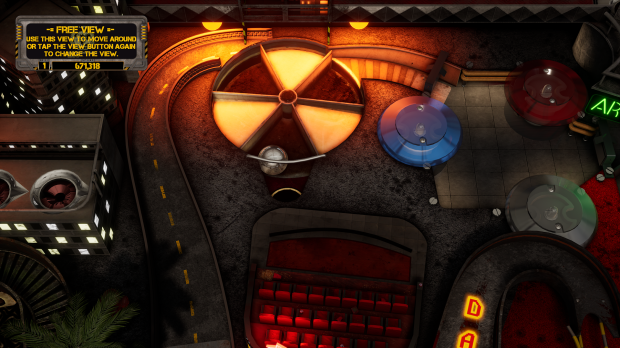
The radioactive symbol’s spin disc is the highlight of the table, in my opinion. It’s a clever idea. Balls that land in the black zones will be fed to VUK and count towards a random award. Balls that land in the yellow zones will instead be released into the bumper area of the table. Good idea. I sure wish it didn’t require six spins on the right zones to do anything.
The Vice Family is probably Zen Studios’ best case scenario for players. A family that shares a love of the sport and competes with each-other, all three of whom are capable of challenging for world records. We’re far removed from the best players, but we ain’t slouches. If we couldn’t do these things, who exactly are these tables designed for? Zen’s original tables these days rely on mind-numbing grinding combined with made shots still having the potential to kill you because the ball return is done in a way where it might be unplayable. Presumably their design team thinks this is the key to engagement, since mobile games are about mindless grinding and random odds. But, like.. it’s pinball, gang. I know I sound like a broken record, but your best sellers are adaptations of old Williams/Bally pins that might be hard (nobody can accuse Indiana Jones, Twilight Zone, or Addams Family of being too easy) but they don’t require players to practically earn a bachelor’s degree in that table just to experience everything.

After completing each mode, you have to charge up the left spinner and then shoot the toilet scoop to activate “boss fights” which feature cardboard targets, the big one of which takes roughly fifty billion hits to kill, give or take. It’s actually over a dozen hits combined for the minions and big boss. While it does have a ball save attached to it, the ball save is going to come out under the damned DAMN ramp, again reducing your survival to random chance. If Duke Nukem has a feature that COULD have been fun, you can bet your sweet ass the designer made it require so many hits that it becomes a joyless slog. You can also shoot the toilet scoop to use a gun, but this feature is incredibly confusing and frankly underwhelming. The targets are there, but we’re encouraged to shoot elsewhere? Huh?
I originally had Duke Nukem as GOOD, agreeing with everyone else that Duke has a fun, downright frisky layout with nice ramp placement, a unique and memorable skillshot, and genuinely thrilling side-targets. It’s a damn fine layout, besides the way the ball return is handled. It even incorporates zone-style design by having the bumpers being completely segregated from the rest of the table. Even more striking is that Duke Nukem doesn’t feel like it’s aping Williams or Stern. It’s the rare Zen original pin that feels genuinely original. Even though the flow is left-side heavy, it avoids having the feel of a table that’s been cut in half, like A Samurai’s Vengeance suffered from. And Oscar would disown me if I didn’t single-out the fine-tuned scoring balance, which my daddio was positively swooning over. It’s so precisely balanced that it would have made the late, great Lyman Sheats proud. Don’t take my rating to imply any lack of talent. They DO have talent. So much that the problems Zen has with forced grinding and dickhead ball returns are much more frustrating than they should be. If they had no clue what they were doing, it’d be excusable. They’re so good at making pins that the faults are inexcusable.
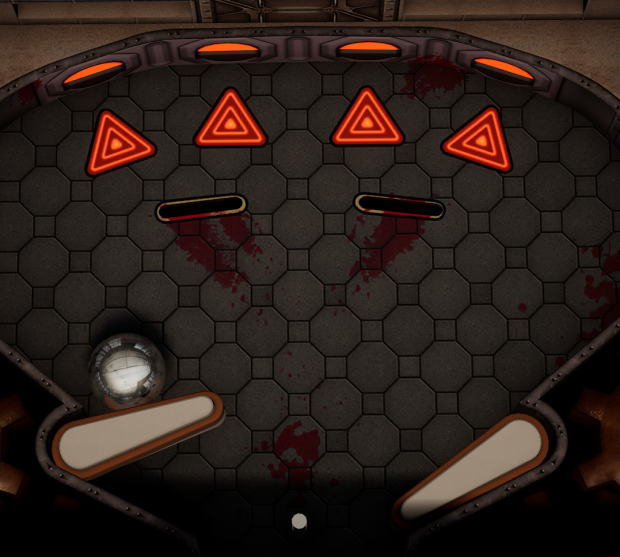
Yet another continuing problem with Zen’s originals is that they include mini-fields with gaps so wide you could drive a steamship through them. Seriously, it’s remarkable how they’ve gotten into these company-wide bad habits. Grindy modes. Harbor-sized flipper gaps. By the way, Zen, a drain pin doesn’t help when the physics of the mini-table make the ball feel limp. Duke being accused of having limp balls seems like the type of thing that would make him fly into a rage, but I’ll take my chances.
Saying that I know Zen is capable of better than this is an understatement. Duke Nukem’s Big Shot Pinball has a layout so awesome that it should have been a cinch for a GREAT rating from me, and really, MASTERPIECE should have been in play. It has everything I like in a layout. It’s telling that none of us even considered MASTERPIECE. That was ruled out really early. I don’t know why anyone would make such a great creation and then destroy it by discouraging table exploration like Duke does. The multiball modes seem fun. I wish I could justify going for them, but activating them takes so many hits and requires you hold your breath and hope the ball return doesn’t screw you over that it’s not worth attempting. Grind. Grind. Grind. Why on Earth do you want people to have to shoot targets so many times to accomplish ANYTHING? I don’t get it. Imagine you were golfing and you sank a long putt, but instead of that being a good thing by itself, you then had to spin a wheel where there’s a 20% chance the hole would fire the ball into the closest water hazard and force you to start over. That’s how Zen’s original tables have been lately, and I’m sick of it.

Duke Nukem is left-side dominant. In 50+ hours of playing, to the best of my knowledge, none of us got the random award from hitting the targets behind the spinner 100 times. Yes, ONE HUNDRED HITS. The bumpers were equally bad. They’re laid out in a way where the ball just goes dead and rolls lifelessly to the lethal ball return hole under the DAMN ramp. Zen, seriously, it would be so easy to salvage this. Sure, the ball return is busted and you can’t fix that, but just cut the requirements for modes and hits the bosses need by at least half. Don’t want ANYONE to finish this shit? One or two players in the entire world see the wizard modes on any given Zen original, and you think that’s a good thing? Because it seems to me average or casual players would consider it so far out of reach that it’s not even worth exploring. How likely do you think they are to recommend your pinball games to other people? Probably not very likely.
I’m done rewarding these grindy tables with positive reviews. Enough with modes requiring so many shots to finish that it’s practically sarcastic. Enough with requiring an entire lifetime of devotion just to see everything a table has to offer. Do you want to unlock one of the multiballs? Well you have to shoot the spinners a couple dozen or so times AND light the C-O-O-L targets and.. oh you already drained out? Too bad. Want a random reward? Well you have to shoot the toilet scoop ten times (without starting any other modes) and then shoot the.. oh, you already drained out? Too bad. Want to start “I’m the Cure” mini mode? Well you have to shoot the black colors on the spin disk 6 times then hope the wall randomly wiggles enough to get 60 hits on the NEST targets to light the.. oh you already drained out? Too bad. Enough is enough. Look at the leaderboards. Those scores are pretty low. Clearly you didn’t want anyone unlocking much, so hey, you didn’t unlock a positive score from me. I’m rating it BAD.
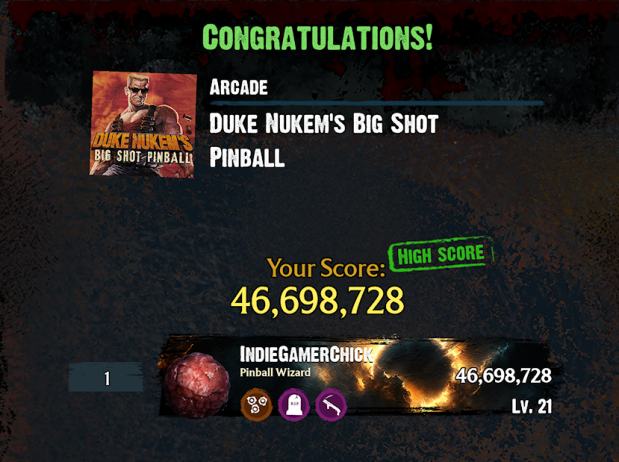
As of this writing, this is the highest score ever recorded for Arcade mode, one of two primary play modes. The previous high was Angela, using an entirely different strategy. That’s reassuring. The best thing I can say about Duke Nukem is it offers enough flexibility that multiple different strategies are viable. Angela chose to charge-up the two-ball multiball and just repeat it over and over. Of course, the score Angela put up that I beat required an absurd amount of grinding that, by her own admission, was the least fun way to play. “Hey, I’m the world champion though so HAH.” She’s going to wake up to find that’s not even the case anymore, as I literally just put this up before publication.
Again, I’m the lone hold-out here. Everyone else, despite their frustration with the same stuff I’m whining about, had fun. A really good theme, excellent layout, satisfying shots, and fine-tuned balance really do make Duke stand out in a crowded field. For all the bitching you just sat through, even I had fun. I mean, up to a point, but every time I started really enjoying the table, Duke went back to obnoxious grinding and random chance deaths. I just had one of my best games. I was hitting my shots. I couldn’t miss, really. I set a new world record. But all three balls drained from the ball return hitting the left slingshot, which sent the ball into the right slingshot, which sent the ball directly down the left outlane. It wasn’t just three times, either. IT WAS FIVE TIMES. Twice I had protected the left out lane with a kickback. It didn’t matter, because eventually you have to give up skill and simply cross your fingers. When I did, the result was predictable: ball return, left slingshot, right slingshot, left outlane, dead ball. I’m done. Five outlanes in one game where I couldn’t have shot better. Duke Nukem pinball doesn’t want to be fun. It wants to be a troll. One of the best layouts Zen has ever done and the final product is more obsessed with being a prick than it is being fun. Zen, if you want your original pins to require a marathon of shots to make anything happen, that’s your prerogative, and I’ll never understand it. This isn’t pinball. It’s a war of attrition.
Cathy: BAD (2/5)
Angela: GOOD (3/5)
Oscar: GREAT (4/5)
Jordi: GOOD (3/5)
Dash: GREAT (4/5)
South Park: Butters’ Very Own Pinball Game (Pinball FX Table Review)
 South Park: Butters Very Own Pinball Game
South Park: Butters Very Own Pinball Game
Platform: Pinball FX
Set: South Park Pinball ($9.99)
Included in Pinball Pass
Designed by Szucs “ndever” David
Originally Released October 14, 2014
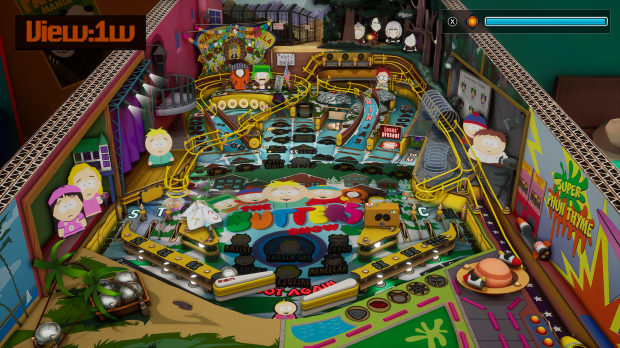
This is a reminder that Butters made multiple earnest attempts at destroying the world, by drowning everyone and by destroying the o-zone layer. Oh sure, it was adorable how ill-conceived and childlike his attempts were, but they were good faith efforts at human extermination. He’s not THAT wholesome.
It’s probably best that pinball fans look at the Butters table as a throw-in bonus for South Park: Super-Sweet Pinball, where $10 nets you one really well done PG-rated South Park pin and one middle-of-the-road, mundane and average pin. Which isn’t to say that you should ignore Butters’ Very Own Pinball Game. I really did think it was completely decent. It’s just impossible to build-up any momentum thanks to Zen’s typically violent slingshots and over-indulgent modes. In this case, I think the slings are easily the worst part. Seriously, holy crap, those slingshots should be in a holding cell, staring at a clock as it inches closer to midnight with a priest reading them their last rites while a pair of three-drug cocktails, a gurney, and IVs await in the next room over. They’re silverball serial killers that, all by themselves, drop Butters from maybe as high as a GREAT table to barely GOOD. Well, actually the horrendous mini-field with physics so weirdly inconsistent that it’s practically broken doesn’t help, either.
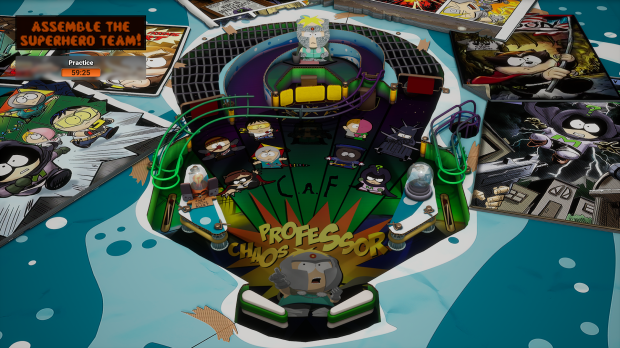
Oof. Terrible.
While they don’t look the part, the flippers for the Professor Chaos mini-table feel nubby. The physics for the mode are completely different than a normal table. The Vices all agree that the slope feels non-standard, but we disagree as to whether it’s too shallow or too steep. It kind of feels like it alternates between both, depending on where the ball is. Regardless of whether it’s too steep or shallow, flips on the mini-field have this weird shuffle-pass sensation. It’s as if you’re playing pinball with an air hockey puck that has fluctuating weight. As if that’s not bad enough, the four targets are boring AND that you have to shoot them twice each. Combine that with the fact that there’s no ball save, and thus rounds of this catastrophe could end in literally a second or two, and it quickly became my least favorite of the table’s modes. This might be the worst mini-field Zen has ever done. It really put a damper on the whole Butters experience, because I really don’t think their physics have ever been worse.

You absolutely MUST play the ball out of the saucer or risk a quick drain. While it’s not a 100% certainty, the drop from the saucer hangs right over the drain. If you’re not attempting to shoot the cellar or spin disc, what you can do safely is hold the bat flipper out, which should give you a gentle drop down to the primary flippers to gain control of the ball.
The rest of Butters is all about basic, nearly bare-bones light-shooting. Modes are started by putting the ball in the saucer in the center of the playfield, then converting the follow-up shot with the bat flipper into the spin disk. The disk is surrounded by several targets, and by total chance, you have to score 50 hits on the targets. It sounds like a lot, but you shouldn’t need more than two successful shots in the spin disc. Between the three members of my family, ONE TIME in an entire week of playing this table did one of us need three shots, whereas completing all 50 in a single shot wasn’t rare at all. In extremely rare cases, the ball gets launched out of the spin disk, though it should be playable even if this happens. After lighting the mode start, you’re given five options. The worst is Chaos vs Coon & Friends, which is entirely the mini-table I whined about above. By far the easiest mode is Marjorine, and the scoring is completely screwed-up on this one. You only need to complete three shots and return the ball to the mode start VUK. Each of the first three shots gives you two options. Besides the third shot, all four of the shots score in the millions of points. It’s a cinch.

I’ve heard of shooting bricks, but this is ridiculous.
Last of the Meheecans is indicative of everything Zen Studios does wrong pinball modes. The previous mode I talked about was four shots, all simple angles, and only one of which is an optional high-risk shot. This one is seven shots, all of them with much higher difficulty, all of them much more risky, and all but one of them score much less points. In this mode, you have to shoot five orbits, but the entrances to those orbits have rising-and-lowering walls. Once you clear four of the five orbits, the final one must be shot three times, and it’s only now you’re putting up million point scores. And you’re on a timer, on a table with long return times. Because hitting each shot once just plain wasn’t enough, I guess. How come Marjorine is four shots for more points and this is seven shots for less? It makes no sense.
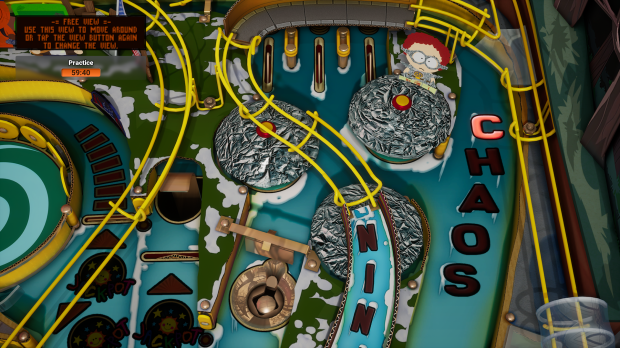
Butters relies heavily on the bumpers for the AWESOM-O mini-mode and for the high-yielding dress-up Butters score. As long as I wasn’t on AWESOM-O the ball would bounce around like crazy in the bumpers. But, as sure as the sun will rise, whenever I was on the AWESOM-O mode, the ball would bounce out after a single goddamned bump. Two bumps at most. It was so uncanny that I’m convinced it’s rigged.
The other modes are under-paying and just totally average. Turn butters into a vampire by shooting three orbits and then the saucer three times. Put on a Hawaiian shirt and shoot fifteen orbits with a multiball. There’s also a couple side-quest multiball modes as well that are the same basic modes with fewer targets and an add-a-ball mapped to the generous vari-target. I normally hate vari-targets (they’re my least favorite pinball targets) but this one is clockable and relatively safe off a brick. Sadly, most of the mini-modes are quite dull. The only one we all universally enjoyed was the Ninjas side-mode. There’s four ninja targets and you have 60 seconds to shoot them for 150,000 points a hit. They respawn five seconds after being struck down, but if you can complete all four within five seconds, you score ten million points. Again, I can’t stress enough: none of us HATED Butters. We just hated that no amount of skill can overcome the slingshots, and the complete lack of balance. But, let it be said that the Williams-like layout and simple angles makes for a nice bonus to go along with the unforgettable Super-Sweet. Now then in the spirit of Butters, GO TO YOUR ROOM, ZEN! YOU’RE GROUNDED FOR THOSE SLINGSHOTS!
Cathy: GOOD (3/5)
Angela: GOOD (3/5)
Oscar: GREAT (4/5)
Jordi: GOOD (3/5)
Dash: BAD (2/5)
Dave: GOOD (3/5)
South Park: Super-Sweet Pinball (Pinball FX Table Review)
 South Park: Super-Sweet Pinball
South Park: Super-Sweet Pinball
Platform: Pinball FX
Set: South Park Pinball ($9.99)
Included with Pinball Pass
Designed by Peter “Deep” Grafl
Originally Released October 16 2014
Awarded a Certificate of Excellence by The Pinball Chick Team
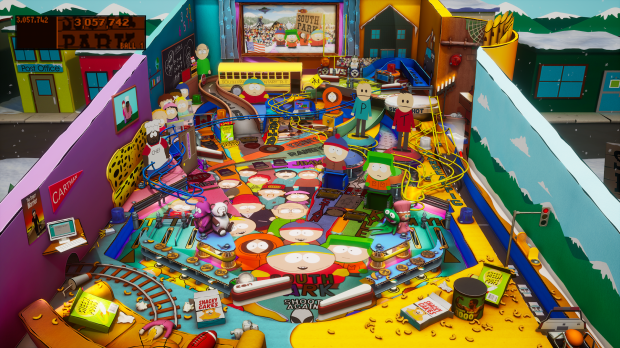
Keep in mind that our team’s fandom of South Park as a show is all over the place. Dad (Oscar) and Dash are 100% complete lifetime non-fans. Myself and Jordi are lapsed fans, while Dave is somewhere between the two groups. Only Angela is a modern “never misses an episode” fan of the show and even has viewing parties with friends. Some of us factored in the theme, others focused on the table. One odd note is that Zen is just weeks away from releasing Pinball M, their M-rated Pinball FX spin-off (oh.. hey, I get the name now), but this South Park is rated E 10+ by the ESRB. There’s not even bleeped cussing in here. Weird.
South Park’s tables being returned to Pinball FX after a six year absence is proof positive that all bets are off with Zen Studios. As if getting the World Cup and Indiana Jones licenses didn’t already prove that, now they’re bringing back their long-lost Pinball FX2 pins as well. South Park: Super-Sweet Pinball is probably their most famous pre-PinballFX3 pin (it’s either it or Plants v Zombies). It’s back, and it plays well with the new Pinball FX engine. Super-Sweet pinball is a smooth-flowing finesse table only somewhat held back by a brutal difficulty combined with modes that demand too much perfection in what is an imperfect art form.
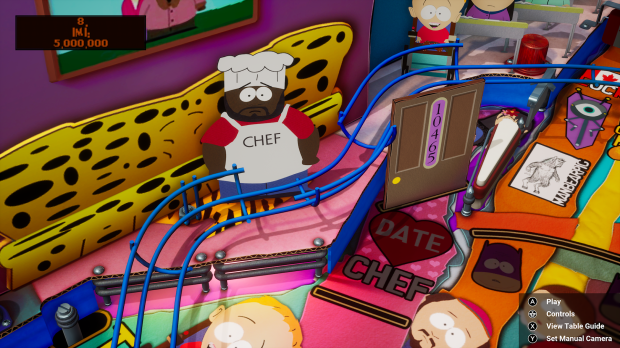
The Vices (that would be myself, Angela, and Oscar for those keeping track at home) have put 30+ hours into Super Sweet Pinball. For all the whining you’re about to endure, we all really enjoyed it. However, some of the angles are too impossibly risky. Chef’s door is a whole other level of “WHY DID YOU STICK THAT THERE?” mind-f*ckery. Unlike Dash and Angela, I never considered moving off my GREAT rating. The risk/reward balance is too screwed-up for that.
Super-Sweet isn’t entirely an original table by Zen. Hold a mirror to the layout and it’s a close approximation to Stern’s Simpsons Pinball Party. I don’t know if that was meant to be a “Simpsons Already Did It” joke or not, but given that Ant-Man is a mirrored version of Theatre of Magic, probably not. The similarities are mostly superficial in nature, though South Park does take after Simpsons with multiple highly stackable modes. Unlike Simpsons, you can’t go into the settings to adjust the hurry-up times. The biggest problem with South Park is how damn unforgiving it is. It’s not enough to activate the modes. The modes have to be finished to achieve the S-O-U-T-H-P-A-R-K lights that are the ultimate object. That’s nine modes, with three additional modes (one of which is a grindy multiball). Finishing four of them lights an extra ball, but even on our third day, it wasn’t all that rare for each of us to finish games with only one light (typically it was the Kenny light, which is a lay-up). And, we really don’t suck at pinball. Hell, I’m the reigning Arcade mode world champion on this table at the time I’m writing this, and I finished that game barely halfway there. They’re a LOT of work just to get started, THEN you have to.. you know.. beat them!
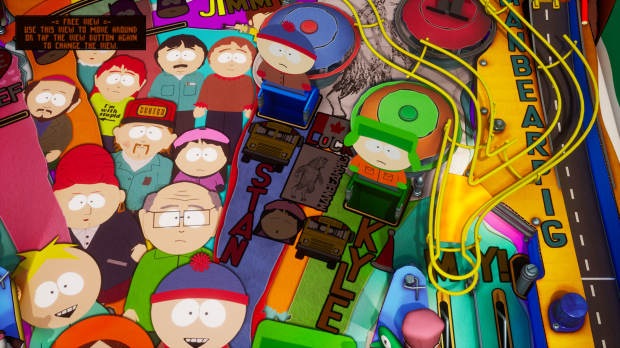
The Stan and Kyle scoops are deceptively hard shots. For Kyle, if you have a gentle roll on the right flipper, a backhand is a relatively safe option. Stan? Not so much. If there’s a low risk angle for it, we haven’t found it. Annoyingly, despite being a very high-risk shot, Stan’s hurry-up is too short and very undervalued relative to its difficulty. Really, the only value it has is it gives you the S light. Lighting four of the S-O-U-T-H-P-A-R-K lights will light the extra ball target. My suggested order is Kenny, Sarcastaball (which has an additional extra ball attached to it), School Bus Multiball, and Manbearpig. You can sub Stan’s Hurry-Up (annoying as it is, once it starts, it’s one shot to complete) for any of those. The Vices NEVER successfully completed Kyle’s mode (Mr. Hankey Multiball) or Chef’s mode. Not once.
Let me pick an almost random example: the School Bus Multiball. To get it, you must shoot the school bus ramp NINE times. You must then lock four more balls shooting the same ramp. THEN, you must complete the shots for all four of the boys AND sink the balls back in the bus ramp you had to grind nine shots out of to begin with. I’m fairly sure that you need to only lock one of the balls to get the “R” letter, but either way, this is massive grindy time investment. I can’t stress enough: the most successful pinball tables of all time kept their “doors” lit whether or not you were successful in the mode or not. That’s the kind of pinball that generated the biggest success the medium has ever had BY FAR, so why wouldn’t you do that, Zen? You have 110+ tables on Pinball FX, and you expect HOW BIG a time commitment towards “git’n gud” at them? Kyle’s requires you to get the K-Y-L-E lights, then 3 locks on the sarcastaball-ramp, THEN you have to get a super jackpot in multiball. AND IT’S ONLY WORTH A MILLION POINTS for that super jackpot.
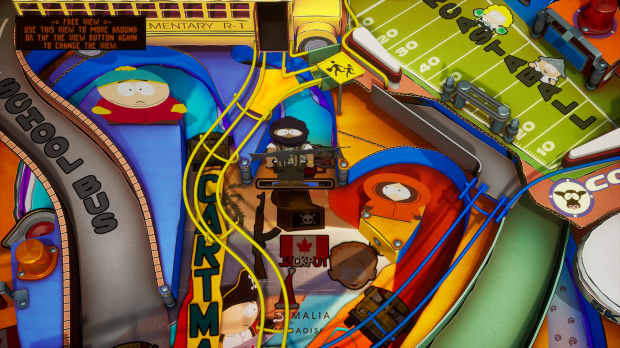
The super skill shot is quite risky. I had a lot of shots go straight down the drain off it. You should have the ball save lit, but still, it’s a bitch. When this target isn’t standing, it’s replaced by a TV target that requires you to hit it.. I’m not making this up.. 247 times just to light an extra ball. Come on, Zen. Now you’re just straight-up trolling. It’s worth noting the “episodes” you get from hitting this add to your end-of-all bonus as well. If I shoot a target 247 times, I expect the table to gain sentience and eat me. Though actually, at one point, I had an EB light that I couldn’t figure out where it came from. It’s entirely possible it was from this.
Compare the relatively low scores of the other modes to the T-I-M-M-Y mode, which is NOT for one of the letters but yields the highest scores. By far! Timmy’s easy-to-get lights are along the flipper lanes. After lighting them, you have thirty seconds to go nuts on a single shot next to the Kenny loop. Use the left flipper and a cherry-bomb shot, and you’re gold, OR, you can use the bat flipper. Yep, the best target in the game can be shot from both the left primary and the bat flipper, and boy, does it score points. You only need to hit it once and you’ve got a cool million points, and it adds another million every time you repeat it. Do the TIMMY shot twice, and you’re made three million points. Three times? Six million. Four times? Ten million. And so forth. And so forth. You can grind that one shot, 30 seconds at a time, and still score hundreds of millions of points. You can use this as an excuse to light the C-A-R-T-M-A-N lights, since that shot feeds you a softball for the bat flipper to shoot the TIMMY shot. Oh, and if you miss it off the bat flipper? You’re either hitting the Kenny Loop, Randy Ramp, or if you’re way off, you’re hitting the J-I-M-M-Y lights for the kickbacks! It’s so badly balanced. My arcade world record right now is probably 40% to 50% made of that one shot. That’s not balanced. I should note my father disagreed with me all weekend about how low-risk it was, since the Timmy target is a cherry bomb shot straight over the drain. I almost never lost a ball from it. He’s just plain wrong.
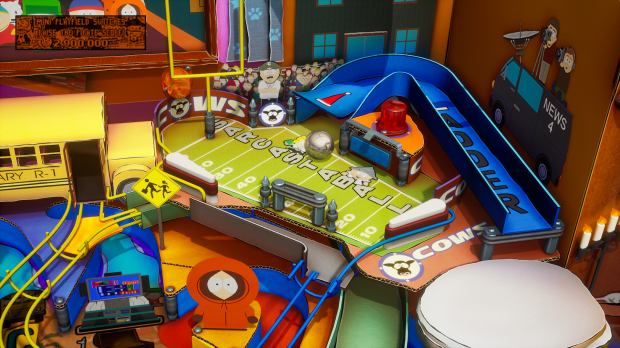
Assuming the mini-table doesn’t glitch out on you and ruin your game (and it might), you’ll want to get good at it since the extra ball light is that cow up at the top of it. The biggest pinball mistake Angela will ever make is letting me see how she cracked the super skill shot. Here’s how: let the ball “settle down” on the right (lower) flipper before flicking. It should bounce off the target and roll around the goal post. Grind this up to a 10 million point level and then complete the super skill shot on the main playfield to light an extra ball. Takes practice but I can now do it almost every time. It’s HIGHLY clockable. The balloon part? Not so much. Another tip: don’t shoot the tethered balloon directly. Use the same strategy as I stated above and DO NOT shoot the balloon directly. ANY contact with the balloon will light the S-A-R-C-A-S-T-A-B-A-L-L lights, even if it’s on the return. Now, when the balloon is cut loose from the tether, sorry friend, but you’re on your own. I sucked at it.
Will someone in charge at Zen Studios tell their table designers to tone it the f*ck back, already? Because the tables aren’t better for demanding this much commitment out of them. The tables aren’t ever more fun because of the repetitive grinding. They’re less fun. Nobody is going to devote six months towards one table to get good enough to get the wizard mode. Look at how few people are posting wizard-level scores on Zen Originals versus Williams pins (that don’t require endless grinding with no forgiveness for failure) and ask yourselves which tables people are having more fun with? I know I’ve been whining about this a lot lately, but it’s an issue. People aren’t finishing these tables. GOOD PLAYERS aren’t. That’s not a virtue.
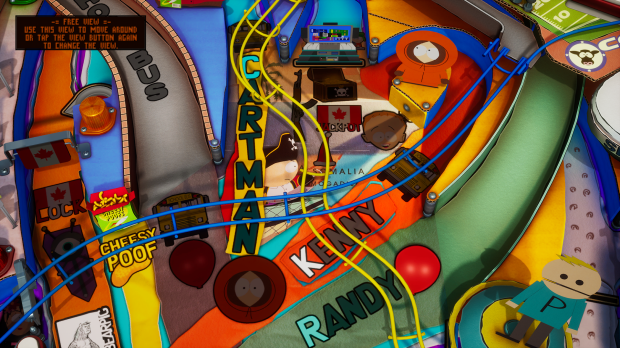
This screenshot alone is PACKED with incredible shots. Dad coined the Kenny loop a “shoelace loop” or “The Ritchie Shoelace” which is a close cousin of “The Ritchie” as seen in tables like Black Knight, High Speed, etc. Oh, and Kenny is probably the easiest letter on the entire table. Or, you can shoot the Randy loop, which is a bit tougher and activates the super-grindy Bat-Dad mode. Or, one shot on the Randy Loop also lowers the blimp to activate Sarcastaball and grant access to the mini-table (where an extra ball can be nabbed). OR, you can get the T-I-M-M-Y lights and then shoot the Timmy vertical target, which is potentially the most valuable shot on the table. Finally, the J-I-M-M-Y lights that activate the valuable kickbacks are just under the Randy shot, though it’s nearly a blind-angle off the bat flipper.
Now, with that whining out of the way, I should probably note that we all loved the layout for South Park. Of all the “super difficult” Zen originals, South Park is probably neck-and-neck with Clone Wars for having the best transitional flow. While South Park is absolutely packed with modes and mini-modes, the transitions from shot-to-shot are smooth regardless of what modes you’re aiming at. And, unlike Whirlwind, we could use post transfers to great effect this time. You’ll need passing for this one, as the key modes are timed. Cartman’s Anal Probe requires thirty spins of the spinner in sixty seconds (approximately four flush shots), and at that point, you’re only halfway there. You then have hit three UFOs in thirty seconds. Manbearpig is ten shots, then a straight-shot up the middle, THEN collect six piles of gold, THEN one final cherry bomb up the center. Bat-Dad is the hardest by far. You have to shoot a high risk cardboard target to “throw a jab” which ticks off a little bit of his health. To “throw a haymaker” and do extra damage, after hitting the cardboard target, you have to very quickly connect on a follow-up flashing light shot. I have no idea how many times you have to do this. We never came close to finishing it. We never finished the Chef’s mode. They were too high risk, and it made more sense to shoot the TIMMY lights for maximum yield.
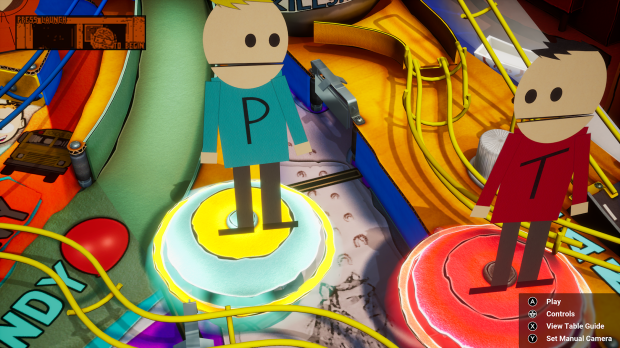
The Terrance & Phillip themed bumpers are incredibly violent and, when their mode is charged-up, high-yielding. Angela at one point banked nearly ten million points off them in a single shot based solely on pure blind luck of getting the ball jammed between them. There’s also a Lawlor Path between them that acts as Stan’s Hurry-Up shot, as well as additional Canadian Multiball and Manbearpig shots. However, it’s a very high risk shot, and the bumpers, fun and profitable as they can be, may also murder your ball via the right outlane or even a drain plunge. I held my breath every time.. which feels oddly fitting for fart-themed bumpers.
The big question is “can non-fans enjoy South Park?” I actually think it might be true of both non-show fans and non-pinball fans. Don’t mistake my usage of “super difficult” for being “impossibly difficult.” It’s not that bad. Actually, South Park: Super-Sweet Pinball is an incredibly fun table. Strangely generous too. Take the Cheesy Poof bag, for example. It’s the score multiplier and it’s right next to two necessary shots: the left Manbearpig/Canada/Cartman orbit and the school bus ramp. If you brick either of those shots, you get rewarded with the Cheesy Poof bag, which is fairly low-risk to hit. In fact, the entire left side of the table is so tame and workable that it’s practically gentle. You’d never imagine that South Park is a steel ball serial killer. Oh, it is, and it can be maddening in how many different shots can kill you. But, while I still firmly protest how much work Zen expects people to do to earn wizard modes, all credit where it’s due: it never gets boring, at least with this table.
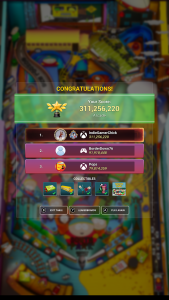
Cathy’s, who took the crown from Angela, who took it from Cathy.
Cathy: GREAT (4/5)
Angela: GREAT (4/5)
Oscar: MASTERPIECE (5/5)
Jordi: GREAT (4/5)
Dash: GREAT (4/5)
Dave: MASTERPIECE (5/5)
CERTIFIED EXCELLENT BY THE PINBALL CHICK TEAM
Star Wars Episode IV: A New Hope (Pinball FX Table Review)
 A New Hope
A New Hope
aka Star Wars Episode IV: A New Hope
Set: Star Wars Pinball Collection 1 ($23.99)
Designed by Peter “Deep” Grafl
Originally Released April 29, 2014
Included in Arcade1Up’s Star Wars Table
Awarded a Clean Scorecard by The Pinball Chick Team
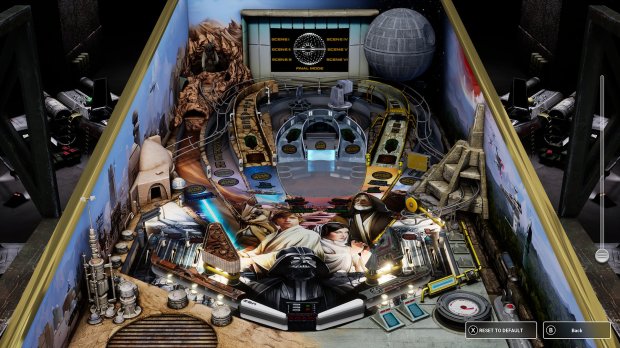
You have to wonder if they knew a decade ago they would some day make a My Little Pony table if they would have saved a horseshoe shaped table for that.
Our family nickname for A New Hope keeps getting more and more elaborate. It started as the “Big Horseshoe” then it became the “Great Horseshoe” and now it’s at “The Great and Powerful Horseshoe.” This is probably how religions get started up. By 2025 it’ll be “The Almighty Galactic Horseshoe of Divine Holiness” and we’ll still be unanimously stuck on rating it GOOD. It’s the definitive middle of the road Zen original that both delights us and breaks our hearts with its squandered potential. Still, there’s no doubt that A New Hope holds up in 2023, nearly a decade after its release. But, a decade later, all the warts that were inherent to it all along are more and more glaring. Despite the playfield being made almost entirely of orbital shots, you have incredible freedom in A New Hope. Each of the orbits is tied to a bonus mode, and the T-U-S-K-E-N orbit is also the mode start. Getting into a groove building combos is incredibly rewarding, especially since they were spot-on valuing combo shooting.
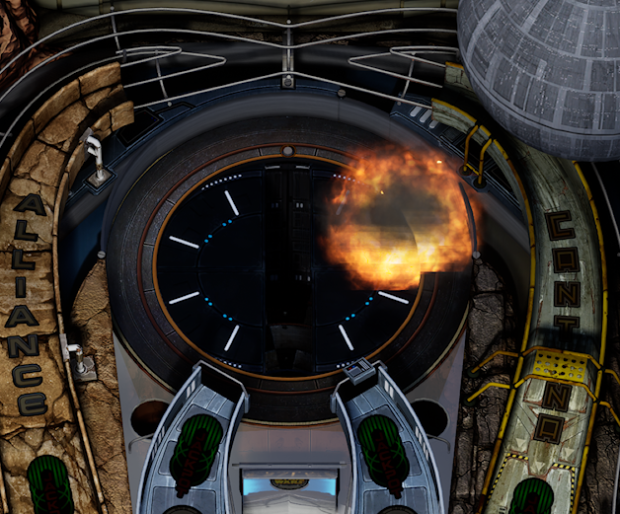
A New Hope jerks off with its animation too much. I’ve had multiple instances where I nail the Hidden Skillshot dead-on, only instead of, you know, GETTING POINTS, the ball explodes because the table is STILL loading the playfield because there’s so many useless animations. Sometimes modes take FOREVER to get going or to end because it takes forever for a stormtrooper or Obi-Wan to waddle their fat asses off the table. WHY WOULD YOU DO THIS, ZEN? Everything should be already in place, but Zen crammed so many masturbatory animations into this pin that sometimes the speeder is still positioning itself and the ball bounces off it, or sometimes a stormtrooper literally scratches their head looking around. I often have to hold a trap for 15 or more seconds waiting for everything to reset after a mode ends. That’s beyond ridiculous.
A New Hope’s biggest annoyance is a magnetic playfield in the dead-center of the playfield that randomly throws your ball, potentially down the already deadly outlanes. That magnet is such a weird decision. I guess it’s supposed to be the force field of the Death Star, but my question is: why does it fling? Just have the ball bounce off it like a wall. Also, several of the main modes (especially scene 6) and the hurry-up bonus mode require you to shoot ball onto a temporary mini-field in the center of the screen to fight enemies, but sometimes the physics and the ball don’t cooperate and the ball just plain explodes for a soft reset. The modes are NOT generous with their time, and since it takes too long for the ball to reset, it only really serves to create frustration. There’s also just too much reliance on luck in the bonus modes. It’s not really possible to guess (or react quickly enough) to the Tusken Raider, and the video mode (along with its ultra-valuable extra ball) is totally random.
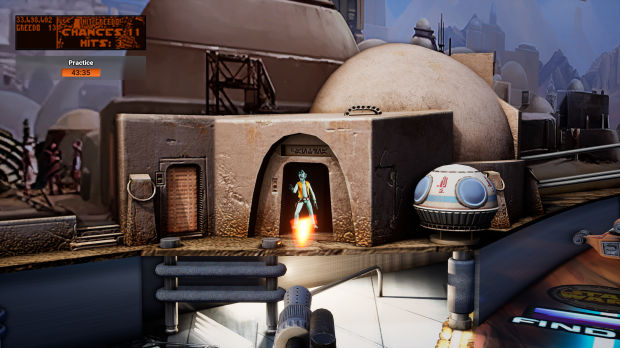
Oscar on Mode Balance: Ideally, side modes in pinball, once you factor in the work to activate them and the risks of shooting them, have full parity. A New Hope’s side mode balance is completely out of whack. Both the Cantina shooting gallery and A New Hope’s Video Mode have the ability to light the valuable extra ball lamp within them. Lighting the video mode, where scoring and rewards are 100% luck-based, requires you to to light the letters A-L-L-I-A-N-C-E on the non-dominant left side of the table. A relatively higher risk shot for an unknown reward. Comparatively, the easier to play shooting gallery requires one fewer letter (C-A-N-T-I-N-A) across what is arguably the table’s primary orbit. Both orbits feed the R-E-B-E-L lights that drive the modes, but you’re incentivized to shoot A New Hope left-to-right due to the left outlane being much easier to defend against. It’s a tiny lack of risk/reward parity that throws the balance of A New Hope into the garbage disposal.
There’s lots of other annoyances. A New Hope has some of the most pathetic kick-backs ever. They sort of lightly volley the ball up and onto the playfield, but the gentle arc created often throws the ball right between the flippers. I’ve had multiple instances where a kickback sends the ball straight down the drain. Like, straight down it, and man alive, does it piss me off every time. I don’t know what Zen’s fetish is with this kind of weird “could only happen in video pinball” invisible force field kickbacks that don’t really help players and instead, just as often, are worse than trying to manually defend against the outlanes. I have to go back to what I’ve asked of them a million times: do you want to make good pinball tables or do you want to be a complete f*cking assholes and troll your customers? Because you can’t do both at the same time. A New Hope is a potentially great table that they took a sledge hammer to, and I don’t get it. Why would you do these things the way you did them when it doesn’t add challenge so much as it just trolls the players? I want to note that my sister is calling me a “cry baby” right now, as she likes the way this handles the kickbacks. She’s adopted, and I’m the reigning arcade mode World Champion of Star Wars: A New Hope as of this writing, so my word counts and her’s don’t. Thems the rules!
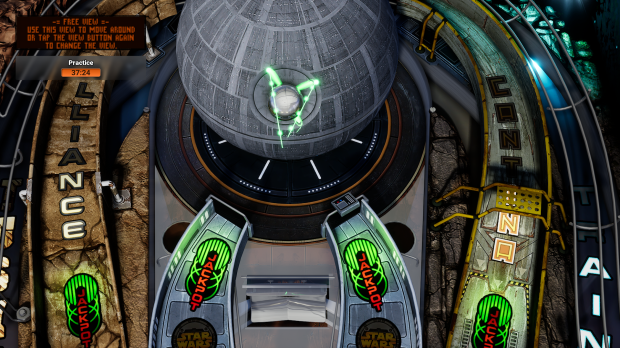
Then again, the Death Star modes are all pretty dang good. I can’t imagine it’s possible to better mimic the most iconic battle scene in sci-fi better than A New Hope does. It saves the table!
What frustrates me most of all is that A New Hope could be one of THE elite Star Wars tables with some modifications. Shortening-up the modes would be a good start. We’ve been playing these tables for four years now, and A New Hope is one of the tables we’ve played the most of any Zen table. It’s arguably THE signature table of Zen’s Star Wars pins. Yet I’ve personally never started the Wizard Mode, and Dad and Angela each only have reached the wizard once apiece. Ever. Going off the leaderboards, it would seem 99.99% of players never get that far. There’s just too much work getting there. The hurry-ups don’t offer enough time, especially on a table that wants to look good more than it wants to play good (this is known as Russell Westbrook Syndrome, or at least it should be) and thus it could take FOREVER to get the ball back to the flippers. I will never understand how Zen can see themselves get more attention for classic Williams announcements, but then go so overboard on creating their modes. You don’t need a mode to be a multi-tiered, almost no room-for-mistakes marathon. The most popular pins of all-time didn’t do that. What are you trying to compensate for, Zen?
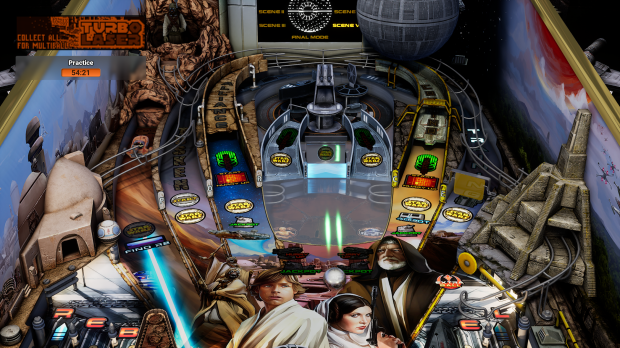
I’ve had these blaster shots roll up the lane and down the outlane. Made shots should never have potential to die. Ever.
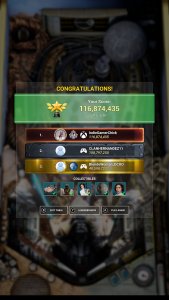
Most of our records are set by Angela these days, but I am the reigning Star Wars A New Hope Arcade Mode World Champion at the time of publication. Also, my father is A New Hope’s One Ball Challenge World Champion and Angela is the Distance Challenge World Champion and a former Flips Challenge record holder. VICE FAMILY DOMINATION!
For all my whining, there’s a reason why we keep coming back to A New Hope, and not just because it’s the first table alphabetically. Long as the modes are, they never feel like a grind, like some Zens get saddled with. It’s a good case study on how fun a Zen table can be even when they screw up so many things. The layout is iconic. It should feel gimmicky, right? It’s f’n giant horseshoe right in the middle of the table. That’s ALL it is. But it works. The multiballs are all exciting AND challenging. The rails are brutal, BUT, you’re giving enough nudge warnings to defend against them. Angela, our best player, credits A New Hope with learning how to defend the outlanes with Zen’s physics. We all agree the biggest problem isn’t the magnet or the long modes: it’s the lack of focus. A New Hope doesn’t do any one thing spectacularly. It tries to be all-encompassing of the video pinball experience. That’s the thing about being a jack of all trades: they’re masters of nothing. Apparently, that includes The Force too.
Cathy: GOOD (3/5)
Angela: GOOD (3/5)
Oscar: GOOD (3/5)
Jordi: GOOD (3/5)
**CLEAN SCORECARD**
Whirlwind and Pinball FX’s Physics (Pinball FX Table Review)
 Whirlwind
Whirlwind
Platform: Pinball FX
Stand Alone Release ($9.99)
Included with Pinball Pass
Designed by Pat Lawlor
Conversion by Zoltan Pataki
Awarded a Clean Scorecard by The Pinball Chick Team
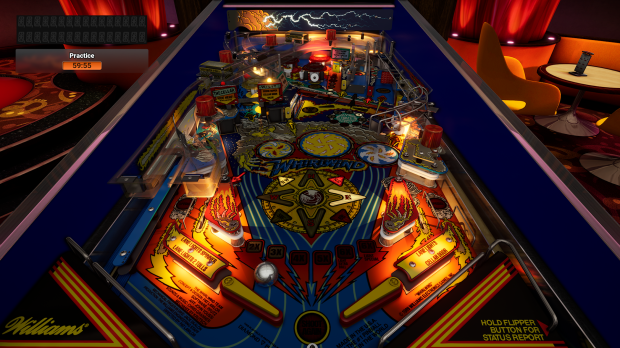
Real tables of Whirlwind are infamous for popping bricked ramp shots. Each of the Vices had MULTIPLE instances of triggering fly-overs in this digital pin, only instead of going into the chute, the fly-overs would get “captured” by the right habitrail, which almost always led to a drain. The ball returning to the playfield was nearly impossible to defend against when it happened. It would have no speed or momentum and limply fall straight between the flippers. At one point, it cost me a world record in the arcade mode. Well, you know.. missing the shot ALSO cost me it, if you want to be technical, BUT THE FLY-OVER DIDN’T HELP, and it’s made worse by the fact that Angela took that same world record the very next game.
Whirlwind feels like the last Pat Lawlor table that came out of his mad scientist laboratory that didn’t completely make logical sense, before whatever epiphany he had where he suddenly could do no wrong for a six year stretch. Funhouse? Now THERE’S a table that makes sense. Whirlwind has a roughness to it that makes you raise a skeptical eyebrow, as if to say “you thought this was going to be a lot better, didn’t you?” I think Lawlor thought this would be his magnum opus, and it’s not even close. In fact, it might actually be Lawlor’s least elegant table that doesn’t rhyme with “Chafe Whacker.” The three spin discs just don’t add as much anarchy as you’d assume they would. I feared the slingshots a LOT more than the discs. Thankfully, on the default settings, even an average player should be able to grind out an extra ball in a couple seconds just by shooting the right ramp a few times followed by one wide-open drop target. If you were an arcade patron in the late 80s/early 90s, I imagine Whirlwind seemed like an astonishingly generous pin, a rarity for this era. Of course, that’s lost in translation on the journey home, along with the famous fan topper that spins when the discs on the table do. You could do what I did and hold a portable fan to your father and sister’s face when the discs start spinning, but I don’t recommend it UNLESS you’re 100% certain your family’s threats to murder you in your sleep are empty.
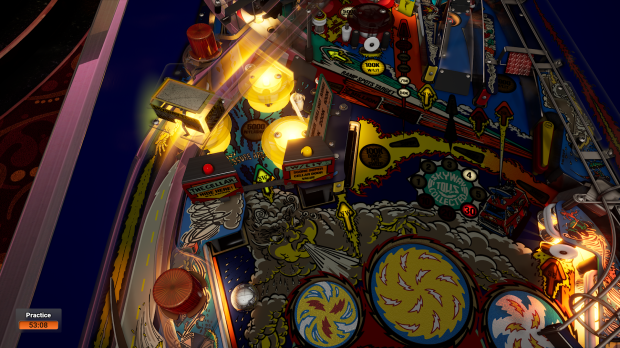
Since Pinball FX’s physics seem to be tailored to block not-so-advanced advanced moves like post transfers, we were forced to use the cellars for right-to-left passing. I suppose it helps drill the shot into muscle memory, but it also brings into focus the problem with Pinball FX: it REALLY doesn’t want you to pass the damn ball from flipper to flipper. You know, like you can in real pinball. This is a table that NEEDS passing to work perfectly to maximize its playability.
Still, one has to cheer for the absolutely bonkers design. Two clusters of jet bumpers, each with its own “mode” attached to it (for lack of a better term). Three spin discs. One of the finest uses of a raising/lowering ramp. This is a really visually striking pin. Of course, the biggest issue with Whirlwind’s design is that it only requires you to drill three shots into muscle memory: the upper cellar, the ramp, and the bat flipper’s left ramp shot. Those three shots alone score all the jackpots, light all the “modes” and allow you to play around the spin discs, which were never really that big a risk in the first place. Well, provided you don’t hit the right slingshot. It’s a serial killer, that one. You can shoot the compass lights if you want, but completing the left ramp checks off those lights too. Not only that, but it relights the cellar lamp, which is the table’s driver that activates the modes. While the left ramp is a difficult shot, it’s also not as risky as some of those compass lights are. This was why my father refuses to go above GOOD for Whirlwind: it’s an overvalued shot that throws Whirlwind’s risk/reward balance off a cliff, and that’s even when it’s not the jackpot shot for multiball. It offers more bang for your buck to shoot it instead of touring the board, giving you the cellar light AND inching you closer to multiball. Remarkably, it never feels like a grind, though. Even if you only take those three shots, they offer enough variation and challenge to make this a fun experience.
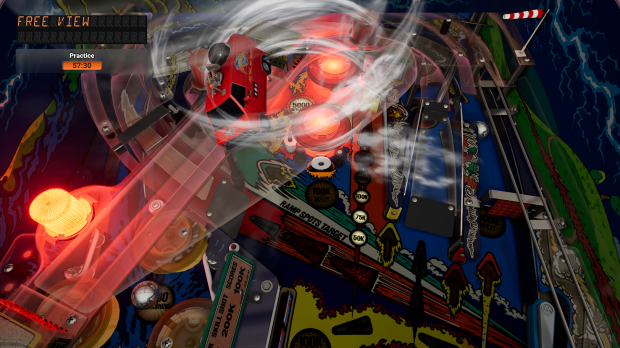
Jordi on Table Effects: With Whirlwind, Zen did a great job of capturing the concept of getting caught in a storm. As the three disks spin, the effects get better and, crucially, they never block the view of the ball. This is how the special effects SHOULD work on all tables. Indiana Jones, I’m looking at your airplanes.
There’s been a recent patch that seems to have eliminated the ability to shoot the left ramp, aka the most difficult shot on the table, using the plunger. I was baffled when that was a thing before, because if that’s something you can do on a real Whirlwind, I must have never played on a properly maintained table. Well, that’s gone, and that’s a positive step. What isn’t good is Pinball FX’s physics, ever since the BIG physics update that Pinball FX3 did after I started covering digital pinball, seems to be tailored to prevent advanced pinball moves. Whirlwind is a table that absolutely requires being able to cleanly and efficiently do a post transfer. This is like the most fundamental “advanced” pinball move, so much so that my father had taught me how to do them by the time I was 5 years old. NONE OF US can do them consistently on Pinball FX. The ball gets too much weird, undefined spin. Where is that spin coming from? It makes no sense.
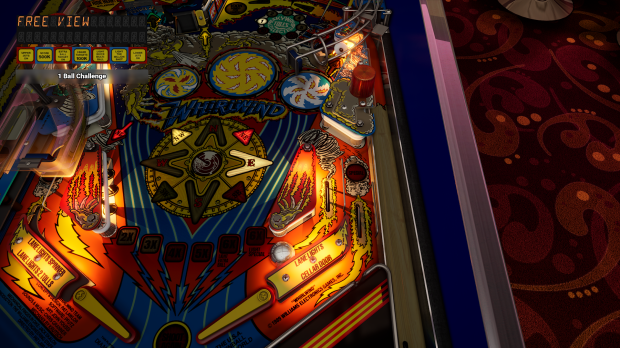
We nicknamed the right slingshot “Murder Inc.” This is arcade accurate, by the way. As big a problem as Zen has with overly-sensitive and violent slingshots in their original works, real Whirlwinds absolutely murderlize balls with the slings.
That’s what I think the most notable thing about Whirlwind is: it highlights why the current Pinball FX physics are even further apart from being lifelike than Pinball FX3’s were when I started covering pinball. Post transfers? Free catches? Alley transfers? Really basic “advanced” moves? SIGNIFICANTLY harder to do, if not impossible, and it seems to be tied to the ball’s rotation since it appears to have backspin and completely loses its momentum on a dime. This happens CONSTANTLY in Pinball FX and prevents even fundamental moves from being viable. The only possible explanation I could come up with was that it was done to beef-up the difficulty for professionals by taking away their “cheats” or something. Take that, Tarek Oberdieck! How else do you explain why, in 2023, Zen Studios keeps putting out tables with worse and worse physics when the technology running the simulations is getting better? Maybe they cut off their nose to spite their face (and pros) because someone saw the same handful of players on top of the leaderboards and panicked. Even if I’m wrong as to WHY they did it, they did it, and some tables suffer for it. Whirlwind certainly does, along with every Williams pin. But hey, I wish I could pass the ball in their recent Mandalorian table too, so even their original works suffer.
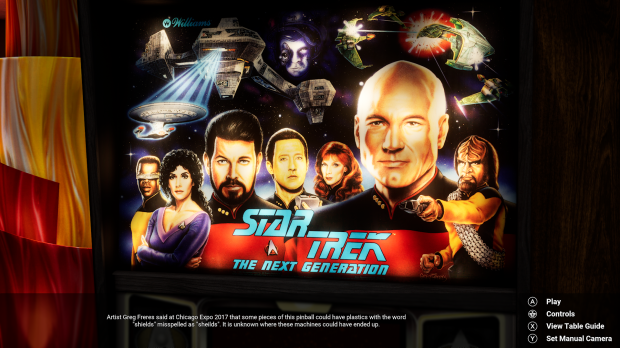
If you think the physics are murderous in Whirlwind, hoooo boy, just wait until we finish THIS review.
Meanwhile, they never updated the Star Wars Pinball collection on Switch, where I can literally feel the difference. I can pull off the same type of moves I do on a real table on there, despite the fact NONE OF THOSE WERE EVER REAL TABLES! It’s much more life-like! I switched back over to Pinball FX, tried fundamental passes, and the ball would just stop halfway and fall lifelessly down the drain. Another sign that they’ve tweaked the physics can be found in their Jurassic World build for Pinball FX, where the mode start sinkhole just lifelessly drops the ball literally right at the drain. I’m not talking about bad luck. I mean the mode start just sort of lets go of the ball AIMED directly between the flippers. It didn’t used to do this. Angela played three games of Jurassic World this week where, including ball saves, the mode start VUK threw an unplayable EVEN WITH NUDGE (and nobody seems to like Pinball FX’s nudge but they stubbornly refuse to improve it) in 75% of the times she hit it. This is what it looks like (sorry, we play in table mode).
Now, to be clear, Jurassic World is the only Pinball FX3 table that is so busted by the translation to Pinball FX that The Pinball Chick Team has no choice but to rate the table BROKEN. But, I still wish Zen Studios would completely overhaul their physics. We’ve all reached the point where we prefer Zaccaria, because we can actually pull-off the moves that you can really do in pinball. It’s 2023. Why is this not better? Why is Pinball FX’s physics REGRESSING towards feeling more like video pinball and less like a video pinball simulation. Is it to make it compatible with the (100% optional if you’re on a Williams table) enhanced graphics? Because in today’s Pinball FX, you can’t pass the ball. You can’t do live catches. Three physics modes and none of them feel right. That’d be impressive if not for the fact that it’s not as good as tiny upstart Magic Pixel’s physics? In fact, it’s not even really close anymore. Can I do a transfer pass? No? Then it’s not pinball. It’s video pinball. If Zen’s fine with that, cool. It’s not a deal breaker for us, obviously. The angles off the flippers and the ball speed MOSTLY are accurate. It’s just hugely disappointing given they were on the right track years ago, then the train went completely off the tracks. The ball behavior never feels right, and it used to. If their goal was to stop Tarek, fail. He still dominates the leaderboards for the Williams pins. He’s a good shooter, and that’s really the only aspect of pinball that Pinball FX is #1 with: shooting angles. My muscle memory from real tables works on Pinball FX. That’s 80% of the struggle in making realistic video pinball. But finesse? Do you know what the key to playing Whirlwind is? Passing. And what is ten times harder to do on Pinball FX today than the Pinball FX3 that I started playing video pinball with? Passing. You can do better physics, Zen, and I know you can BECAUSE YOU ALREADY HAVE!
Cathy: GOOD (3/5)
Angela: GREAT (4/5)
Oscar: GOOD (3/5)
Jordi: GREAT (4/5)
A Samurai’s Vengeance (Pinball FX Table Review)
 A Samurai’s Vengeance
A Samurai’s Vengeance
Platform: Pinball FX
Set: Honor and Legacy Pack ($9.99 MSRP)
Designed by Zoltan “Hezol” Hegyi
Awarded a Clean Scorecard by The Pinball Chick Team
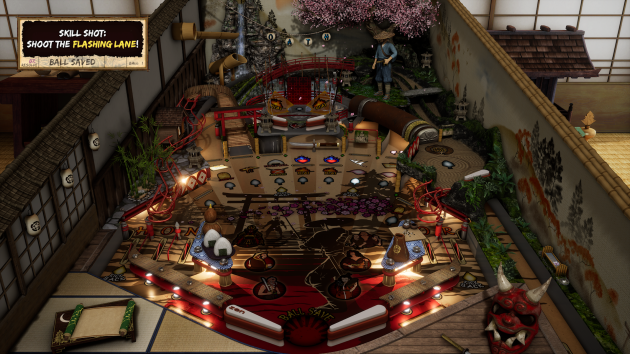
For a newcomer’s first designed table, this really feels like it would earn a student an “A”. Really, it’s only compared to other original works in Pinball FX that a Samurai’s Vengeance falls a bit on the bland, conservative side. But, it falls HARD on that side, so much that it nearly missed out on a clean scorecard.
I hope new designer Zoltan Hegyi and Zen Studios don’t take this the wrong way, but A Samurai’s Vengeance felt sort of like a Zaccaria table. Which isn’t to knock Magic Pixel’s pinball stalwart either. They’ve put out many fantastic tables. What I mean is that Samurai’s Vengeance takes a generic theme, hits every single cliché to go with that theme, stretches the mileage one would expect you could get out of it to near breaking point while somehow not managing to include one single memorable shot, and yet the end result still ultimately ends up being a decent table. Sorry for the run-on sentence. Samurai is so by-the-books that it doesn’t feel like your typical non-licensed Pinball FX release. Maybe that’s a good thing, and for the record, I’m a-okay with busting out all the conventional themes and tropes. It’s pinball. If you can’t be unserious in a serious way, you’re doing it wrong.

The lack of memorable modes or shots does sting quite a bit here. Like so many Zen tables, a lot of Samurai’s problems come down to modes feeling like a grind. In the course of our dueling, which usually involves dozens of games, we never once activated the Random Fortune. It requires you to shoot the Torii gate a whopping eight times. Why would we even do that when all the important shots for the modes are on the other side of the table? We can spend our time grinding up a random award that may or may not be worth the effort, or we can shoot the swinging door katana sword or the spinner to grind up our strength, and then try to start a mode. We know the modes have value. The other side is a massive grind. The multiball requires four balls to be locked, and that’s if the ball lock is even lit. The risk/reward wasn’t balanced properly, because none of us wanted to shoot that side of the table at all. It was too risky when we know that completing the modes yields a final tally of ten million points plus all the scoring that leads up to it. If you’re going to grind, grind the modes, right?
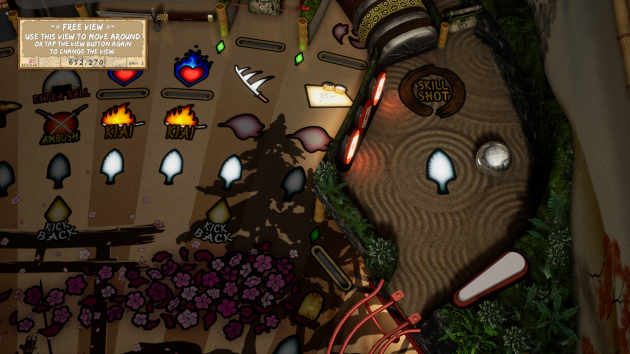
A Samurai’s Vengeance is one of those tables that makes me wish, once again, that Zen would move away from these slow, multi-tiered modes and instead try to replicate the style of pinball’s most profitable and successful era of the 90s. There’s a reason why their most popular tables are recreations of arcade tables from that era: that’s what people like about pinball. A Samurai’s Vengeance has massive pacing issues beyond just requiring so much grinding. When you start a mode, there’s about a fifteen second delay between the mode start and the ball reaching the flippers to start playing again. Mind you, there’s no animation for this. It just takes that long to load. We’re NOT going to get invested in the characters of a pinball table. We’re invested in shooting targets. Now, having got all that out of the way, A Samurai’s Vengeance has good flow, no really offensive flaws, and even a couple gags that gave me a chuckle. I said “oh, you bastards” when they happened, but I also laughed. Will you remember it when you finish it? Not at all. Is it decent enough while you play it? Yep.
Cathy: GOOD (3/5)
Angela: GOOD (3/5)
Oscar: GOOD (3/5)
Jordi: GOOD (3/5)
Dash: GOOD (3/5)
**CLEAN SCORECARD**
Pinball FX: The Addams Family – The Pinball Chick Hurry-Up Review
With over one-hundred tables at launch, I have a lot of work to do to get Pinball FX’s content up. I also have to wait for my team to put their scores in. So, I’ve come up with the concept of a Hurry-Up Review. This is a quick look at the tables as the Vice Family plays them. And, what better table to experiment with this format than Addams Family? We’ve already reviewed the Arcooda version, which we awarded straight Masterpiece rankings for. Of course, that’s a premium priced build designed specifically for those with full-fledged digital tables. This is the version of Pinball FX that works on PlayStation, Xbox, and Epic Games (standard non-table view only), and will be updated when the full team’s scores are in.
 We’ve also reviewed the standard Pinball Arcade build. The big news is that Angela and myself flipped our previous rankings from the standard Pinball Arcade build. She awarded that build Masterpiece status, while I said it was Great. It’s the opposite here. Angela dropped her ranking based on how bad the Thing Flips is at shooting. Yea, a real build isn’t completely accurate either. But, the Pinball FX version is an especially poor shot. It seems to be most accurate if you play in “Arcade” mode, which has a larger ball and feels more like Pinball Arcade. In Classic mode, I started ignoring the auto flipper and took to firing the ball myself. In Pro mode, the table is so steep and the ball moves so fast that the flipper doesn’t even shoot automatically. It’s a significantly more difficult shot to make in Pinball FX. Angela’s strategy of charging up the swamp shot and grinding-up her score (apparently the same strategy used by tournament players) was thrown out the door. It’s why Dash, who would inclined to rate Addams Family MASTERPIECE, dropped his score all the way down to GOOD. The left bat flipper desperately needs fixing. I prefer to shoot manually anyway, so it didn’t bother me. I’ve never been good at shooting it to begin with and prefer to work the doors for my score. Sorry, Sis, but your strategy is boring.
We’ve also reviewed the standard Pinball Arcade build. The big news is that Angela and myself flipped our previous rankings from the standard Pinball Arcade build. She awarded that build Masterpiece status, while I said it was Great. It’s the opposite here. Angela dropped her ranking based on how bad the Thing Flips is at shooting. Yea, a real build isn’t completely accurate either. But, the Pinball FX version is an especially poor shot. It seems to be most accurate if you play in “Arcade” mode, which has a larger ball and feels more like Pinball Arcade. In Classic mode, I started ignoring the auto flipper and took to firing the ball myself. In Pro mode, the table is so steep and the ball moves so fast that the flipper doesn’t even shoot automatically. It’s a significantly more difficult shot to make in Pinball FX. Angela’s strategy of charging up the swamp shot and grinding-up her score (apparently the same strategy used by tournament players) was thrown out the door. It’s why Dash, who would inclined to rate Addams Family MASTERPIECE, dropped his score all the way down to GOOD. The left bat flipper desperately needs fixing. I prefer to shoot manually anyway, so it didn’t bother me. I’ve never been good at shooting it to begin with and prefer to work the doors for my score. Sorry, Sis, but your strategy is boring.

Christopher Lloyd needs them big bucks, so he’s once again absent from the table. The rest of the cast is here.
The big question for me was the magnets. I’ve been wondering how Zen Studios would handle it for a while now. My congratulations to them for NAILING it, as you can now easily overpower them with a trapped shot if you know the right angles for the Seance and Multiball. Yea, they’ll absolutely screw you sometimes, but, so the does the arcade table. While it does feel like a gotcha, I’ve always felt that it’s a gotcha in service to the table’s risk/reward balance. My father agrees with me, which is why he’s awarded Addams Family GREAT, a jump over his score of GOOD for the Pinball Arcade version. Oscar really didn’t like the floaty physics of that build. Those are gone now. Pinball FX isn’t a perfect platform by any means. Backhands are still a bit too hard, but otherwise, this has pretty dang solid physics. Oscar expects a full table-mode will jump to MASTERPIECE, and Angela thinks if a table mode makes it easier to shoot the Swamp, she’ll jump to MASTERPIECE as well. I’m already there. This is the best translation of Addams Family I’ve played that’s not designed specifically for high-end digital tables.

The right bat flipper is one of the hardest to clock in all of pinball. It feels very accurate here.
Addams Family is the definitive 90s pinball table. Multiple shots that are a cinch to drill into your muscle memory, like the Thing Scoop, the electric chair, the Lawlor Trail between the chair and the bumpers. BUT, the easiness ends there. Addams is a punishing table, but, it never stops being fun. I love how it’s a table that incorporates everything seamlessly into the natural flow of the game. I love how every single mode is intense and exciting, with not a stinker in the bunch EXCEPT maybe Cousin It, which is a weird shot and always has been. Otherwise, the modes are splendid. And, has there ever been a better wizard mode than Tour the Mansion? Addams Family feels more grand and super than any of the SuperPins. It’s this strange miracle of a table that I still can’t believe exists. It’s not like the movie was a huge hit, which is why it’s always so amusing to me that this became the biggest selling solid state table ever made. Imagine any other product tie-in for the 1991 Addams Family film becoming the best-seller EVER, of all-time. If the best selling action figure was Gomez in his smoking jacket, you’d be like “huh? How’d THAT happen?” With the pinball machine, it’s easy to understand how it became the biggest seller ever. It’s brutally difficult to learn, so players will have to keep pumping quarters into it, which makes arcade owners happy. BUT, once you get the hang of it, it’s still a beast, where a good game can turn on a dime. Hopefully this time, it’ll not be delisted again.
SCORES
Cathy: MASTERPIECE
Angela: GREAT
Oscar: GREAT
Jordi: TBD
Dave: TBD
Dash: GOOD
Indiana Jones: The Pinball Adventure (Pinball FX3 Team Review)
Indiana Jones. I always knew some day you’d become part of Zen’s lineup. I never doubted that. Something made it inevitable. So, what are you doing here in Pinball FX3?
I learned to hate you over the last two weeks! Those damn house balls. That maddening capture ball lane. That succubus you call a left outlane. Pinball fans have waited for Indiana Jones: The Pinball Adventure to come home in an official capacity for almost thirty years. I think that has a lot to do with the table practically having an out-of-order sign tattooed on it. It’s a machine infamous for having issues and being unsuitable for routing in locations without a technician on stand-by. It’s a member of the SuperPin line, but it doesn’t feel like it. Some of the concept was done in part by Brian Eddy, but it doesn’t feel like it. Like Twilight Zone before it, you go into Indiana Jones aware that, no matter how much fun you have, it was a doom harbinger for the sport itself. The final table to join the 12K Club, and the second-to-last table to clear 10,000 units sold (Star Trek: The Next Generation was the last to do so). Of course, that’s purely on technical failings that have nothing to do with digital pinball. The Pinball Chick Team universally enjoyed the table, to varying degrees, and we all had different thoughts on it.
Made of Stern-er Stuff
by Angela D. Vice
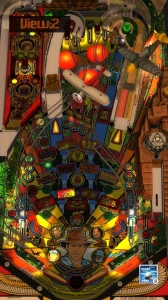 Of the twenty-two conversions of real tables Zen has done, Indiana Jones: The Pinball Adventure is the most modern-feeling. Or, at the very least, tied for first with Theatre of Magic. There’s twelve modes, but really, there’s nine shots you need to commit to memory for those modes.
Of the twenty-two conversions of real tables Zen has done, Indiana Jones: The Pinball Adventure is the most modern-feeling. Or, at the very least, tied for first with Theatre of Magic. There’s twelve modes, but really, there’s nine shots you need to commit to memory for those modes.
- The mode start, which also adds a small bonus to every mode and caps off the Streets of Cairo with a 20,000,000 bonus (or you can fire the plunger button to end the mode at any time with a 2,000,000 point bonus).
- The left and right loops, which are used in Streets of Cairo, Monkey Brains, and Tank Chase.
- The left and right ramps, which are used in Streets of Cairo, Monkey Brains, and Survive the Rope Bridge, along with Steal the Stones and Three Challenges being tied to the right ramp and Path of Adventure mini-table.
- The three center stand-up targets, which are used in Get the Idol and Well of Souls.
- The capture ball, which is used in Castle Grunewald (it’s supposed to be Castle Brunwald).
With an emphasis on the orbits and ramps, not to mention the heavy use of multiballs, you could mistake Indy for being a modern Stern table. Even the fan service aspect, with modes based on memorable scenes from original Indy trilogy and most of the call-outs being samples taken directly from those films, feels much more contemporary than any other table of the 1990s. Frankly, they didn’t make pins like this back then. It doesn’t feel anything like close cousins Addams Family or Twilight Zone, except maybe in the generous amount of extra ball opportunities. The Mark Ritchie-signature cross-ramps don’t feel anything like the ramps of Firepower II, Sorcerer, or Fish Tales. This is a table that should be a relic, yet instead plays like it came from an entirely different era.

Angela: Yes, I’m aware that Stern put out an Indiana Jones table in 2008, but these two tables have nothing in common outside of the theme. The table that my father, myself, and Dave all agreed was the logical evolution of Indiana Jones: The Pinball Adventure? Stern’s 2004 Steve Ritchie modern-classic Elvis!
Even more remarkable is the fact that every single mode is a true thrill to complete. I get tensed-up with excitement every time Raven’s Bar and Survive the Rope Bridge begin, knowing that I can score an extra ball if my accuracy is on point. Choose Wisely, a video mode variation on the shell game, is an easy 25,000,000 points for everyone but my unwise sister, while the Mine Cart game is one of the most inspired and fun video modes in all of pinball. Even the Path of Adventure mini-table gets in on the action, with two modes utilizing it. Did you previously light the Extra Ball or Pit holes before entering those modes? They’re still lit and waiting for you. The more modes you complete, the bigger your end-of-ball bonus. This is especially valuable using the double-the-points boost in standard mode. If the Pinball Chick team did a ranking of all twenty-two Williams tables by modes, Indy would be a unanimous #1. Of course, that’s assuming you actually get to play the modes with all the house balls this table vomits out.
If You Listen to Me More, You Live Longer
by Dash
Folks, this is a tough call for me. With Indiana Jones being indisputably the most expensive table they’ve released to date. Not TABLE PACK. Just “table” by itself. It’s natural to want to ask, why? The answer is simple. Licensing. A record-setting amount of royalty checks had to be cut to make this re-release a reality.
Now, with Zen tables there are two aspects to consider when it comes to “theme”. The first is the original table they are trying to reproduce and build upon. The second is all the extra bells, whistles, and polish that Zen themselves add to push the original over the top and give it their own “special something”. Let’s start with the tables original theme. The cabinet art is nothing fancy. A silhouette and the Indiana Jones text in proper font. The back-box and playfield sport artist renditions of key actors and locations from the only three Indiana Jones movies that have ever and will ever exist (at least in my mind). The rest is fairly generic jungle art which neither delights nor disappoints. Given how much ground they were trying to cover across three films it was probably their safest bet.

Indy has three very fun video modes. The most important of them is Raven’s Bar, which has a valuable extra ball attached to it. There’s a chance you might be forced to choose between the mode-ending medallion or the EB. Take the EB, even if you’ll die after reaching it.
The original art package presents itself very well on my 40” 4k V-Pin screen. Crisp and clean likenesses of Sean Connery, Harrison Ford, Karen Allen, John Rhys-Davies, Ke Huy Quan, and Kate Capshaw all make prominent appearances in call-outs, DMD animations, playfield artwork, and the backglass. I do wish there were a few more call-outs as the ones included repeat a lot. That said, somehow hearing “You cheat Dr Jones!” (spoken whenever you lock a ball for multiball without fully opening the lock) and “You sure know how to show a lady a good time!” never get old. In the way of toys there are a couple of large planes, a rotating “golden monument” which houses and deploys captive balls and a tipsy turvy mini-playfield. There are three video modes which fit the theme. Especially “Choose Wisely” which has you picking the right chalice from a mixed-up lineup.
Then there is the launcher. Here, like on the real table, it’s a button style auto-launcher that takes the form of a nifty Pistol. On the real table, it’s kinda cool. With every launch, I think back to that epic scene where Indy brings his gun to a sword fight, ending it quickly and comically (a result of Harrison Ford needing to go potty really badly). With time and experience, however, it’s come to fill me with dread because the fixed strength launcher means no way to fine tune your launches to compensate for the dreaded and all too frequent “launch, bumper, straight down the middle” house balls that others have mentioned. On the real table the tradeoff was understandable. For a brief moment standing there, you vs the table, you get to feel like Indiana Jones. Here in digital pinball land, though, you don’t really see that launcher during play. Even when you do see it. It doesn’t pull you in and connect you to the table in the same way and all the house balls it leads to make it more trouble than it’s worth. This table feels like it really should have had a plunger. They chose… poorly.

Oscar on the I-N-D-Y Lights: my main complaint with Zen’s standard physics are the bumpers under the I-N-D-Y lights no longer have a lot of bounce to them, so scoring lights here is significantly more difficult than a real table’s. That’s notable, because lights don’t simply charge up a multiplier. They award bonuses that raise the value of loops, ramps, and other shots. Not only that, but completing the lights four times also lights an extra ball. My second complaint? Well, look at the next photo.
Alright, so other than the launcher, all good on the theme right? I wish I could stop right here and say “yes.” But remember… Zen doesn’t just stop with a faithful reproduction of the original, they also add their own flair and this, for me, is where the proverbial minecart goes off the rails.
First the good stuff. Zen has added a zeppelin toy to the upper playfield. Nice. They also added a tank and the Ark of the Covenant on the apron which both have some simple animations tied to related modes in the game. On the playfield the main Indy art between the flippers switches during some modes to show animated sequences in line with the movie events the mode is based on. Very nice.

In table mode, you can’t see the I-N-D-Y lights. This is really a major problem on a table where those lights are so valuable. They really need to make the ramp transparent where it blocks the lights.
Then… there is the animated Indian Jones himself armed with his trusty whip. He whips and swings around the table constantly. It’s usually not too distracting. That said, he’s rather large and crosses the playfield several times each game. So it’s only a matter of time before you lose a ball or two due to him obstructing your view of the playfield as he swings over the playfield during an active ball! He’s like a bad penny, he always turns up and sometimes he costs you a ball. There is also a rain effect that kicks in during the Castle Grunwald mode that doesn’t use any kind of transparency, so if you have a multiball going, good luck seeing through all the rain. This would be unforgivable if it was an easy table. But this is not an easy table. So extra flair that leads to more cheap drains is absolutely not welcome. Turn the extra flair off and you only have the normal house balls off the launch to worry about. It’s a shame to have to do because the rest of the flair Zen added is well appreciated.
House Balls. Very Dangerous. You Go first!
by Jordi
At first glance, the table seems almost extremely easy. There is a wide variety of modes and video modes, and even multiple multi-balls. It’s also very easy to find the mission start hole to actually play all of these. The video modes are especially easy. Raven’s bar is one which you can master and walk away with an extra ball each time. Mine Cart is quick memorization with a middle checkpoint, and Choose Wisely is not at all hard (tell that to Cathy!). In the Zen’s standard single player mode, you can even use the ball reverse power to cheat at the latter two! Then there’s the mini playfield tilt board, which is just perfect. Any mistake here is your own, and not a cheap loss (at least on standard physics. See the next picture’s caption). So all these combined should mean the table is easy and fun, right?

In the rarely-used (going off the leaderboards) Classic Tournament physics, sometimes you can’t get the ball to even fall down the right side of the mini-table at the start of the table, meaning there’s no way to clear the upper-right light. This is why plug-and-play physics are so hard to do right.
Unfortunately, there’s flaws. Every launched ball is at risk of going straight down the middle (STDM). They must have known this was an issue since ball saves are given at every launch and are easily earned, but still, when you start the multiball from the captive lock, you’re going to lose at least one ball with no fault of your own. The multiball which starts from the idol lock is unpredictable, sometimes balls leave so fast you have no time to react and catch them on the flipper before they drain, especially when other balls are already in play.

Cathy on Zen Effects: I hate them for two reasons. #1: they’re distracting. Look at this actual screenshot from the photo-bombing dogfight airplanes flying over the center of the frick’n play table! #2: creating them and putting them in slows down the release rate of classic tables. Most people I imagine play with these effects off.
Then there is the left outlane. This is a wide body so you’d think balls wouldn’t go there all the time. But, once a gall goes for the left side you have to slam the nudge upwards or lose yet another ball. This is also a table where the Zen visual enhancements aren’t as well thought out. On some camera views, the Indiana puppet will obscure the ball as he swings about, and the air-fights that fly around in the dogfight will do as well. If you’re serious about playing a good round, turn those off! Overall, the difficulty in this table does not come from its modes, but from what I can only consider design flaws. The left outlane is badly designed and there should be a pin between the flippers to prevent cheap STDMs. This table could have been amazing but as it is, I am left wondering if the modes were made as easy as they are because the designers knew the cheap ball losses had to be compensated for.
WARTS AND ALL
by Dave Sanders
Mark Ritchie dislikes wide body games. The telltale sign is that Indiana Jones is a WINO. Don’t bother asking what the tipple of choice is; that’s my shorthand for Widebody in Name Only. Remove the idol and look underneath the (never bettered) tilting upper playfield, and what you’ll see underneath is a fairly conventional two-flipper standard body layout, with none of the shots really utilizing the additional space at the sides. Being a WINO does not automatically a bad game make, especially if you want to retain speed; the trick to a successful one is in disguising it with large diorama gimmicks or other places for the ball to go. Data East Guns N’ Roses is a WINO. My own Full Throttle is a WINO. But if Indiana Jones shoots like a standard, how does it retain the relative sluggishness associated with wide body games? And if you’re going to nickle-and-dime the arcade player after the wild excesses of Twilight Zone, can’t you be more subtle about it than with the bitchiest of bitchy left outlanes, and double-STDM house balls from the pop bumpers off the captive ball rubber?

Oscar on the Capture Ball: the kids have it wrong about the capture ball. It’s a high risk a shot, yes. But, a flush hit on it should fall comfortably within the range of the flippers. The issue is the capture ball’s lane has a slopped wall next to it that has too much bounce to it, and that’s what feeds the drain. Of course, that wall is directly next to bumpers, which will create that bounce at random. This is not an issue Zen Studios created. This happens on real Indiana Jones: The Pinball Adventure tables. That’s why professionals are mixed on it. It’s a table governed by foibles outside of a player’s control.
And this is the core issue with Williams Indy. When it’s good, it’s very good indeed. But when it decides to be bad it’s awful. As a complete entity it balances out to so ‘basically OK’ that I can’t shift the ennui of not really wanting to stick it on again when there are some three or four designs of my own that I’d much rather be working on. And that’s not what you expect for a single $15 table, the $100,000 license (if the Farsight Kickstarters are any indication) be damned. (Cathy’s Note: We do not know the full license cost but I’m told it’s the most expensive the medium has ever done)
Granted, pinball collectors and tournament goers (the players most likely to pony up the asking price) are a more forgiving bunch than any casuals are going to be. But for a mass-market product that’s already put out the far superior (and cheaper) fan-shot triumvirate of Monster Bash, Medieval Madness and Attack From Mars, this is not a good look for Zen nor a welcome direction to be going down, even if Indy was guaranteed to sell bucketloads by (a) being so hotly anticipated, and (b) not being the Stern one.

For whatever reason, Cathy can’t win this game. “Okay, I’ll follow the grail and OH look at the moth flying around the room!”
Zen does have a ‘solution’ they could implement if they had a mind to, since the engine uses two distinctive sets of physics. If the flaws in this table are so damn obvious, then why not use the regular FX3 game to ‘fix’ them, and reserve the ‘classic’ physics for the way the machine was intended to be with all the niggling flaws still intact? Wouldn’t it please the larger proportion of a player base that you *should* be attracting? I mean, it’s not like a Dark Souls easy mode, it can’t possibly be that controversial to suggest, can it? At least think about it for when you get to Jack*Bot.
Uh-oh. If you’ll excuse me, either I’ve wandered into a Sega Frankenstein or that’s a rampaging mob of purists with pitchforks and torches about to storm my front door.
Ending and Beginning
by Cathy “Indie Gamer Chick” Vice
This is it. The last of Pinball FX3. It’s been a trip. The sad thing is, although Zen Studios gave us many excellent translations of all-time classics, they only did two tables that weren’t part of Pinball Arcade’s lineup, and this is 50% of them. The other, Space Station, was such a random choice that it’s still shocking, well over a year after it dropped. Indiana Jones isn’t that shocking. Zen works with Disney, who owns the Indiana Jones IP, and they’re made of pinball fans. This was their #1 wishlist table to convert. Of course, bringing Indiana Jones: The Pinball Adventure to their service required more royalty checks than just Disney. That’s how it ended up with a $14.99 price tag.

Oscar on the Ramps: you’ll want to drill these two shots into muscle memory, because half the modes, Path to Adventure, and multiball require them. Especially difficult is the Path ramp, which requires a straight, wobble-free power hit to clear. Don’t be afraid to use multiballs to light the A-D-V-E-N-T-U-R-E lights. The easiest extra ball to get is on the mini-table, but you absolutely need to make this ramp within a time limit, or you have to relight the ramp. It’s the best shot on the table.
That’s a lot for a single pin, and especially for a pin that nobody would call an all-timer. Do you know the scene from Last Crusade where the Holy Grail is RIGHT THERE, and the Austrian chick falls to her death because she won’t give Indy her other hand? “I can reach it.. I can almost.. reach.. it..” That’s this pinball table, and instead of reaching for the Holy Grail, it’s reaching for historical excellence.. and it can’t.. quite.. reach.. it.
And, you know what? It’s not just the house balls. There’s something incredibly off at all times with Indiana Jones. This is a table with an identity crisis. You can choose your own strategy right out of plunger.. BUT, it’s not laid out like a pick ‘n flick. It’s a brick layer that demands precision, or else.. BUT, it’s not certainly not laid out like like a sharpshooter. It has some of the most violent slingshots and downright deadly outlane rails in the sport.. BUT, it’s not arranged like a kinetic. As Dave said, it’s a SuperPin, but not a traditional widebody layout. It feels like a table that wanted to be driven by modes, but had no plans beyond those.

The most notable difference between a real Indy and this digital one is that, in the standard mode’s physics, the mode start locks in much easier.
It’s a miracle that what’s here is as fun as it is. In a table full of juxtapositions, the most fitting one of all is that Indiana Jones: The Pinball Adventure is unforgettable. There’s not a single shot I’d describe as “memorable”, with the possible exception of a lit Path to Adventure ramp (even that requires a large, tilting mini playfield to stand out). Instead, the magic comes from building up completed modes and inching closer to the incredible Eternal Life wizard mode. I don’t think Indiana Jones will become anyone’s go-to table that severs as a fitting swan song to Pinball FX3 and a launching point for the new Pinball FX. At least when it doesn’t instantly kill you.
SCORES (Highest and Lowest are crossed-out)
Cathy: GREAT
Angela: GREAT
Jordi: GREAT
Dash: GREAT
Oscar: GREAT
Dave: GOOD
THIS TABLE IS CERTIFIED EXCELLENT BY THE PINBALL CHICK TEAM
Black Rose Sets Sail to the New Pinball FX
The team at Zen Studios has chosen The Pinball Chick Team to announce to the world that Black Rose, the 1992 Williams piracy classic, will be part of Pinball FX‘s launch lineup! When they tapped the six of us for this task, we had a meeting to discuss what highlights of the table. In the debate that followed, we came to realize that Black Rose is one of the most deceptively loaded pinball tables of all-time. It has something for everyone. Thusly, all six of us have something different to talk about! Why should YOU be excited to experience Black Rose on Pinball FX?
A PIRATE’S LIFE FOR ME
by Dash
In the theme department Black Rose is a masterpiece.
But what makes a great theme?
Some might say “call-outs, toys, and artwork! Duh!”
But I would argue those are merely ingredients, and without the right recipe a great theme is not guaranteed.
The right recipe mixes call-outs, toys, and artwork into a package that builds an immersive world around the player and sometimes, even tells them a story. Yes, pinball can do that.
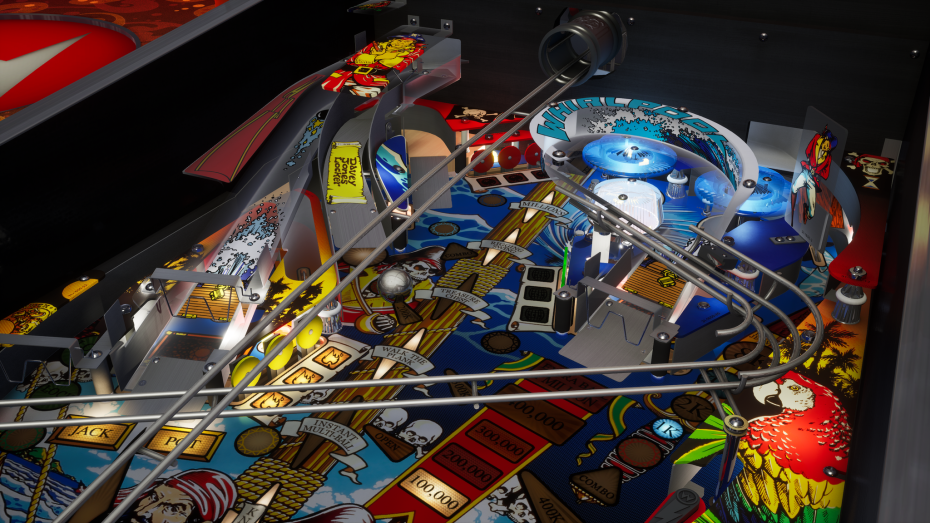
Jordi on the Skill Shot: “The line of Torch targets might be the first thing you aim for on this table, as they’re tied to the skill shot. Successfully score half a million for hitting your target, and you’ll also open the side ramp that leads to Davy Jones’ locker. If you like firing a huge cannon — and who doesn’t — you’ll constantly be looking for ways to open it so that you can lock the ball there and fire that shot.”
Black Rose doesn’t tell a deep story. But it does build an immersive world. You are a new crew member aboard the ship of Black Rose the pirate! Your job is to track down and sink enemy ships with the aid of the primary toy in the game, a rotating cannon. Various bonuses and aids are to be found in Davy Jones Locker which is hidden beneath one of the ramps. Video modes will have you walking the plank and evading sharks, swinging to other ships, and tossing knives. This really does feel like pinball on the high seas! The Zen Pinball FX3 table further builds on this with a 3d modeled and animated Black Rose herself holding tight to the rigging and animated pirate silhouettes swashbuckling in the background. There is even theme appropriate side art blades.
Sometimes Zen can go a bit overboard with the touch ups (Attack from Mars I’m Looking at you!). I’m happy to say that I feel everything in Black Rose is very complementary to the original theme and doesn’t distract at all. Oh, and fans of Brian Eddy will be happy to note that although this was one of his earlier Williams games, if you are paying attention, cows do make an appearance on the DMD. It’s all about the cows.
Black Rose is presented well on Pinball FX3. The visuals totally hold up. Even on a large screen at 4k! And the call-outs are appropriately piratey without coming off as campy, goofy, or overdone. This is about as respectful a take on a pirate’s life as you are going to get. I can’t wait to see what Zen has done with this table on their new FX engine!
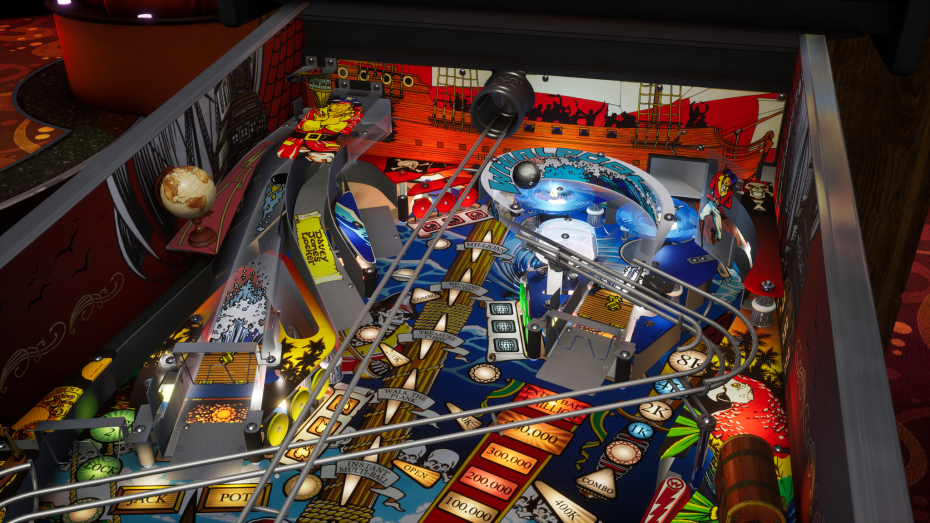
Jordi on the Whirlpool shot: “The whirlpool ramp on Black Rose is one of my favorite shots. Not every hit makes it all the way up there and there is some risk involved in that the returning ball loves to go straight down the drain, but when you do hit the switch the bonuses keep coming. Hit it multiple times in a row for a guaranteed million per shot, until the timer runs out and you get that extra ball.”
THIS SHOULDN’T WORK… BUT IT DOES
by Dave Sanders
Black Rose is like nothing else to poke its head out of the Williams table in 1992.
I mean, look at it! It’s a mess. Can you gather at first glance about how this game is going to play? Liar! The pop bumpers are placed… somewhere. The shots go places but it’s going to require multiple plays just to figure out where. The center shot bisects the whole length of the playfield and into the back, making traditional orbits and loop shots impossible.
But, most of all, get a load of those stand-up targets. They absolutely CLUTTER the middle column of the playfield, all the way down. Cathy and her family coined the term “Valley Style” while I call it “The Grand Canyon”. No real care about where the ball will bounce off them to. The worst possible area at the worst possible vertical angles to aim for with the main flippers. It’s like they threw on the broadside and the stand-up targets first, then put the playfield through a hydraulic press before laying down any of the other shots. Granted, the targets ensure that every near-miss to the Broadside or with the cannon will hit something. But still, who would DO this?
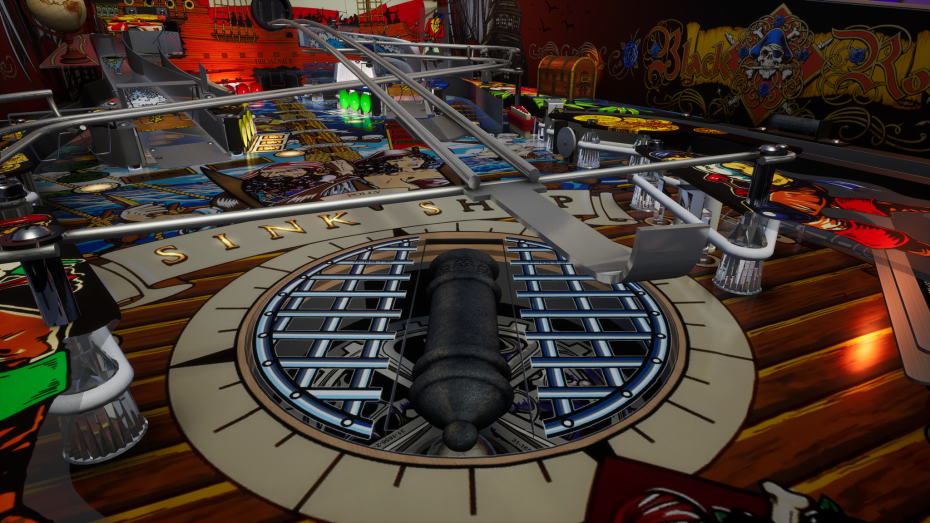
Oscar on the Cannon: “Black Rose is the only table in the sport’s history where the signature shot is a gun: the iconic Cannon. All the practice in the world won’t make your hands sweat any less when you’re deep into a run and aiming to sink your fifth ship of the game. It wouldn’t be until AC/DC two decades later that a pinball’s gun felt THIS intense.”
Wait a minute. Cramped playfield? Haphazard object placement? Shots you can’t follow? Art that doesn’t direct the eye towards those shots, making them even less readable? One shtick that the rest of the game, for better or worse, completely hangs around?
THIS IS LIKE A GOTTLIEB GAME!
And yet, Black Rose pulls it off, and successfully demonstrates that a little variety never hurt anyone. The lead designer (John something), didn’t just graduate from the creatively avant-garde school of layout geometry; he practically invented it, so much so that after he changed companies and left his replacements with weird clown-shaped shoes to fill, instead of Gold Wings and Spring Break (games even more crowded than this one, believe it or not), Gottlieb was putting out the likes of Lights…Camera…Action!, Bone Busters, and Big House that were attempting the same conventions, but the results were uniformly horrible. Still, you have to wonder how much of this was grounded by the presence of future fan-layout specialist Brian Eddy. The center shot is undoubtedly his. (Compare as well the shot openings on Black Rose to those on The Shadow, Eddy’s own least-conventional solo design.) But ultimately, Black Rose is going to leave seasoned players with an impression that this is really a Gottlieb machine, only done properly!
HOT SEAT: THE AGONY OF DEFEAT
by Angela D. Vice

Kiri is Cathy’s name to her family and close friends. Either way, Angela would know about the agony of defeat. She didn’t win a single match in Pinball FX3’s standard mode while we played Black Rose for this feature.
You hand off your controller after a well-played go at Black Rose’s hot seat mode. You made your shots. You hit plenty of combos. You almost got an extra ball shooting the whirlpool. You sank several ships. You’re winning! Your lead is massive. You’re up nearly a hundred-million points. Your opponent is on their final ball. Victory is at hand!
The next few moments are pure agony. Your opponent starts with a lit Double Broadside. For the next thirty seconds, every shot locked into the broadside will double the previous score. One million becomes two million, and then two million becomes four million. You cheer as they brick their fourth shot, your eyes never far from the timer. “How come it didn’t countdown that slowly when it was my turn?” you complain. To your utter horror, they’ve regained control of the ball with plenty of time to continue shooting. Eight million scored. SIXTEEN million scored. Your lead is vanishing quickly, but thankfully, their Double Broadside time expired before they could finish you off. You wipe your brow, then glance at the table and realize they need only one more letter to light the cannon to sink the winning ship. It’ll be their second ship sunk, worth 30,000,000 points. That’s enough to win the game. After a multiball played just well enough to light the letters, they load the cannon. You hold your breath.
THEY MISSED!
The ball bounces around the outlanes, and you’re ready to bask in their failure! They’re grinding their teeth! You gasp as the ball just tips down the C lane. They have another chance, which they capitalize on. They hit the jackpot ramp and feed the cannon off the bat flipper. They take their time, the cannon swaying back-and-forth. The moment they fire, you know you’ve lost. With one glorious press of a button, they’ve sunk the ship, and you along with it. You hang your head in defeat, but you don’t say “I can’t believe they came back.” For with Black Rose, the word “insurmountable” doesn’t exist.
A MULTIBALL LIKE NO OTHER
by Oscar Vice
If you’ll allow me a tired cliché: there’s no multiball quite like Black Rose’s. Instead of merely shooting jackpots, you have three main goals: charge-up the S-I-N-K S-H-I-P letters by shooting flashing lanes, collect jewels, and re-lock the two balls into the Pirate’s Cove to convert your two-ball multiball into a three-ball affair. The cramped valley-type layout might seem too crowded to accommodate this, but Black Rose is a table deceptively tailored towards juggling.
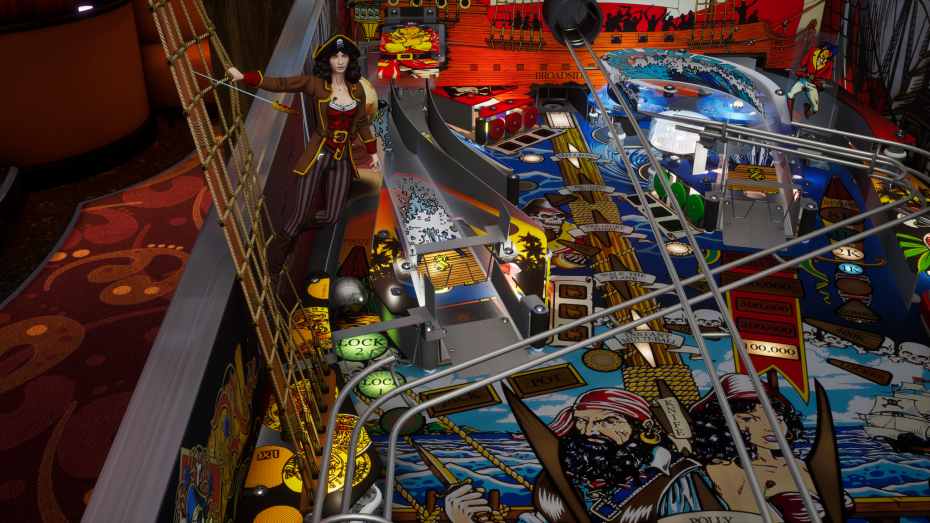
Oscar on the Pirate’s Cove: “one of the reasons Pinball FX’s physics make this a better table is you can’t get a lucky bounce into the Pirate’s Cove. You either make the shot or you brick it. Or, you can be like my daughters and use the cannon to make the shot every time, the cowards.”
Remember, multiball is only as chaotic as you allow it to be. For Black Rose, you control the serve of the second (or third) ball entering the playfield. A full-power plunge will clear the Steve Ritchie-like short orbit that is the closed Davey Jones ramp. As long as you remember that one or two more balls will be entering the playfield from the Pirate’s Cove, you should be able to avoid clearing out the multiball. Once you trap the balls, try to get into a juggling rhythm so you can score enough letters to load the cannon for the valuable SINK SHIP cannon shot. Or, you can go for the extra-valuable Hidden Treasure. And don’t forget: the extra ball attached to the Whirlpool is still yours for the taking, and in multiball, you have more shots to beat the timer on it. For players who like to come up with their own strategies, no 90s multiball offers more flexibility to skillful players than Black Rose.
BRUTALITY ON THE HIGH SEAS
by Cathy “Indie Gamer Chick” Vice
As you can see, Black Rose has a lot going for it. It’s one of the most visually-striking tables of its era. It introduced the world to Brian Eddy, who went on to lead the design of Pinball Chick Pantheon tables Attack from Mars and Medieval Madness. It has a uniquely versatile multiball. It’s well-suited for exciting versus matches. It feels like a table that should be more popular than it is. But, I actually get why Black Rose is one of those pins that gets forgotten in the discussion: it’s one of the most truly weird tables of its time.
Or any time, really. 1992 was the biggest year ever for pinball. Addams Family released and set sales records that stand to this day, and Williams had two other 12K Clubbers release (Fish Tales and Getaway: High Speed II). Data East released its only two 10,000 unit-selling tables (Star Wars and Lethal Weapon 3). Gottlieb’s best-selling 90s table released (Cue Ball Wizard). Of the twelve traditional pins released in 1992, Black Rose finished 10th in sales. Only Gottlieb’s Operation Thunder (which operators didn’t buy as it still used the now antiquated alpha-numeric score display) and Al’s Garage Band Goes on World Tour (from flailing start-up Alvin G. & Co, who had no nation-wide distribution) undersold it. It was hardly a bust or anything. To put Black Rose’s 3,746 units in perspective, Gottlieb, in their entire existence, only had four DMD-display tables that sold more units (in order: Cue Ball Wizard, Street Fighter 2, Super Mario Bros., and the truly putrid Rescue 911). Black Rose was successful. It just wasn’t a major milestone for pinball in a year defined by milestones.
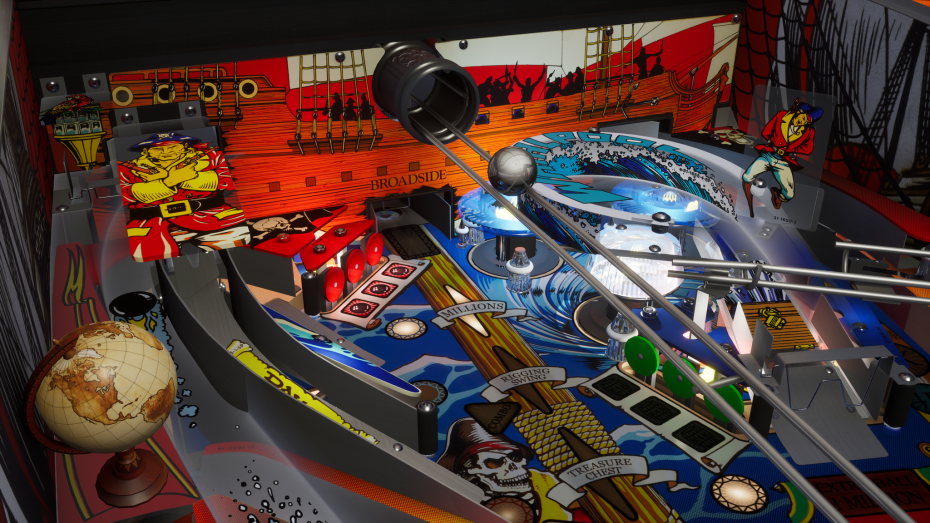
Oscar on the Broadside: “There’s a hole in my ship, Dear Liza. If the Whirlpool is the most valuable shot to commit to muscle memory (it has an extra ball tied to it, after all), the broadside is a close second. It launches modes and has modes tied to it. When it’s not a mode-starter, it could also be a hurry-up shot. In multiball, it’s a scaling mini-jackpot. Players even have a puncher’s chance at an extra ball if Polly spits one out for you. A snap shot from the left or right is required, with the timing slightly different for each side. In the annals of thrilling shots, the Black Rose’s broadside might just be the most under-rated.”
Still, you would think that a table that is this gorgeous and has features that were scorching hot at the time, like the still new autogun, would have been an instant classic. But, Black Rose certainly wasn’t that. Arcade goers in 1992 wouldn’t have seen the cannon straight away, and in the pre-Jack Sparrow days, pirates weren’t exactly a lucrative commodity. But, I think Black Rose was forgotten in large part due to the maddening difficulty. The Vice Family alone put an additional twenty-hours of playtime into the Pinball FX3 build of Black Rose while making this feature. Even well into that twenty hours, it wasn’t unusual for games to end in less than a minute It wasn’t until recently that players started to recognize it for its depth, complexity, and razor-sharp scoring.
Getting good at Black Rose takes time and patience. With the exception of the Jackpot ramp, every other major shot in Black Rose is off-angle and frustrating as hell to drill into muscle memory. Oh, it’s rewarding to do so. Seriously, when you can consistently grind-up extra balls on the Whirlpool, you’ll feel like a world-beater. But, you’re going to need a lot of practice getting to that point. That practice cost players $0.50 a pop in 1992. Sure, there were other vicious pins during this time, but Black Rose is uniquely cruel. It has a fickle ball save that often doesn’t trigger, a primary shot that doubles as a demoralizing death drop if you miss, and one of the most ball-clearing multiballs in the sport. It can be a mean-spirited table. In thirty total Black Rose games played against each-other in Pinball FX3’s Classic mode, only one single game saw one of us break for a hundred-million. It was Oscar, putting up 168,091,440 in his first game. The next highest game didn’t even crack eighty-million. Yipes!
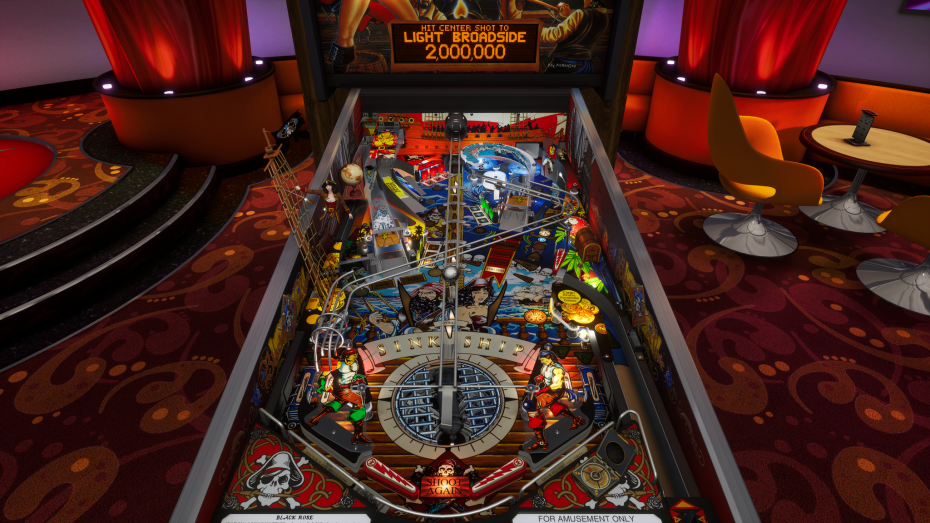
The art direction by Pat McMahon is perhaps the greatest of all time. Originally, Black Rose was to feature dark black pinballs and the table would have been named Black Pearl. But, because McMahon’s darker art direction, utilizing black balls would have created visibility issues. Ironically, “Black Pearl” would go on to be associated with another famous fictional pirate: Captain Jack Sparrow of the Pirates of the Caribbean franchise.
But, that’s the magic of digital pinball. In 1992, it would have been cost prohibitive to “git gud” at Black Rose. In 2022, you can purchase unlimited plays of it on Pinball FX. You’ll have all the time in the world to develop a strategy for multiball, or to practice the Whirlpool shot, or get the timing down just right for the lucrative Double Broadside mode. Black Rose kind of gets lost in the shuffle among heavy hitters like Attack from Mars, The Getaway, Monster Bash, etc. But, it’s one of our family’s favorite score-settling tables for a reason. It’s always exciting. Fitting for a table based around piracy, Black Rose might be Pinball FX’s greatest buried treasure. When it launches as part of the new Pinball FX, it’ll be one of the tables we keep going back to again and again.
Yes, I’m Still Alive
I know I haven’t updated in nearly eight months. The thing is, I am still playing pinball. Playing well? Well..
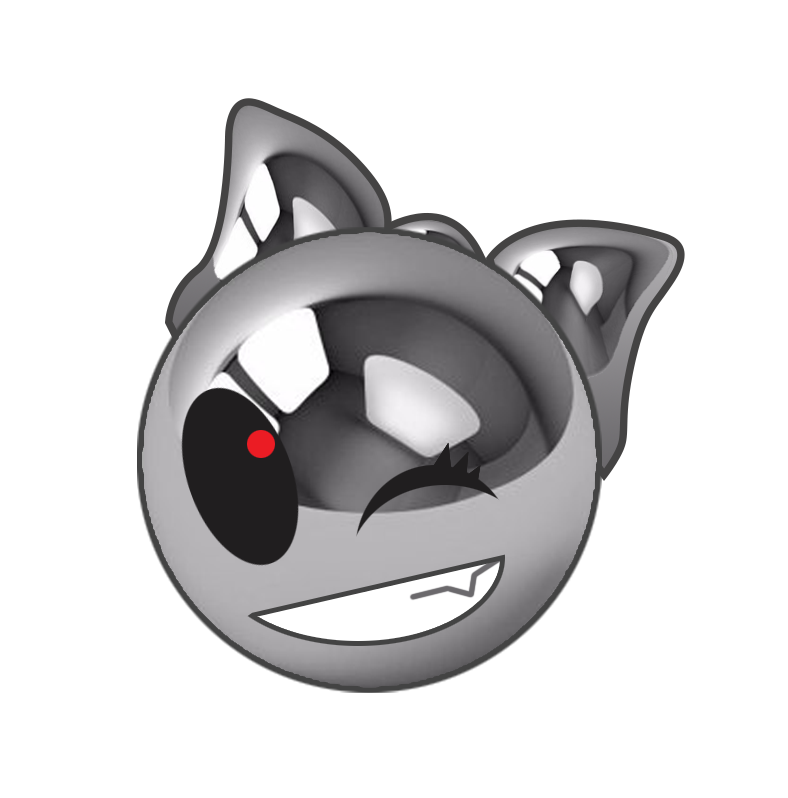 I have Parkinson’s Disease, and it’s starting to affect me. My reaction times are slowing, and that affects my ability to play pinball. It was a tough blow to find out I’m going to be affected by this horrible disease. It’s like “great, of course. That tracks.” It looks like, despite being early onset, it won’t be as severe, but it’s still far too soon to know for sure. It’s looking good, but you can’t know until the disease starts working it’s anti-magic on you.
I have Parkinson’s Disease, and it’s starting to affect me. My reaction times are slowing, and that affects my ability to play pinball. It was a tough blow to find out I’m going to be affected by this horrible disease. It’s like “great, of course. That tracks.” It looks like, despite being early onset, it won’t be as severe, but it’s still far too soon to know for sure. It’s looking good, but you can’t know until the disease starts working it’s anti-magic on you.
But, I’m done feeling sorry for myself. I have a great life and I still love pinball. And I’m not done yet. Besides, my kid sister, Angela, is going to be the REAL Pinball Chick soon. Despite only being eleven-years-old, she has become the best pinball player of our family, routinely beating Dad and I in duels and setting new world records. Angela is poised for amazing things in film when she’s older, but she wants to also eventually take-over The Pinball Chick. “If I make it in Hollywood, pinball will be what I turn to when I need a break.” She loves the sport, and there’s something reassuring that a kid of the 2020s can still have a passion for pinball.
The whole team is ready to put a new generation of digital pinball through the wringer. We’ll be looking at Pinball FX3’s Indiana Jones Pinball Adventure conversion in March. We’ll be evaluating new Zaccaria tables. And buzz is, Farsight isn’t totally out of the pinball game yet. We’ll be here, ready to shoot jackpots for you.
-Cathy Vice
Indie Gamer Chick

You must be logged in to post a comment.